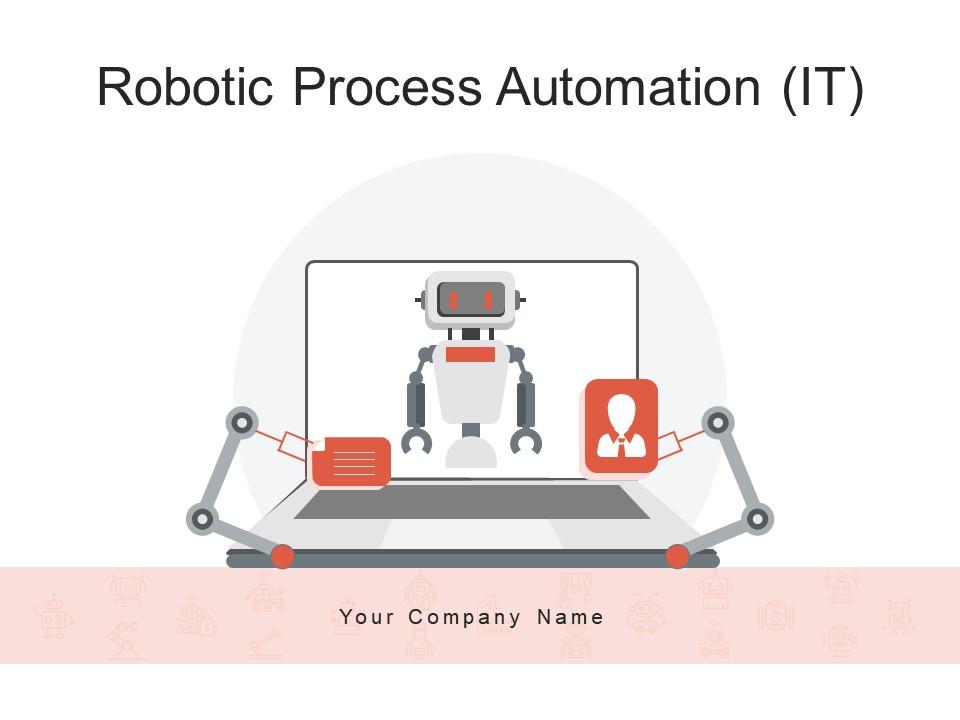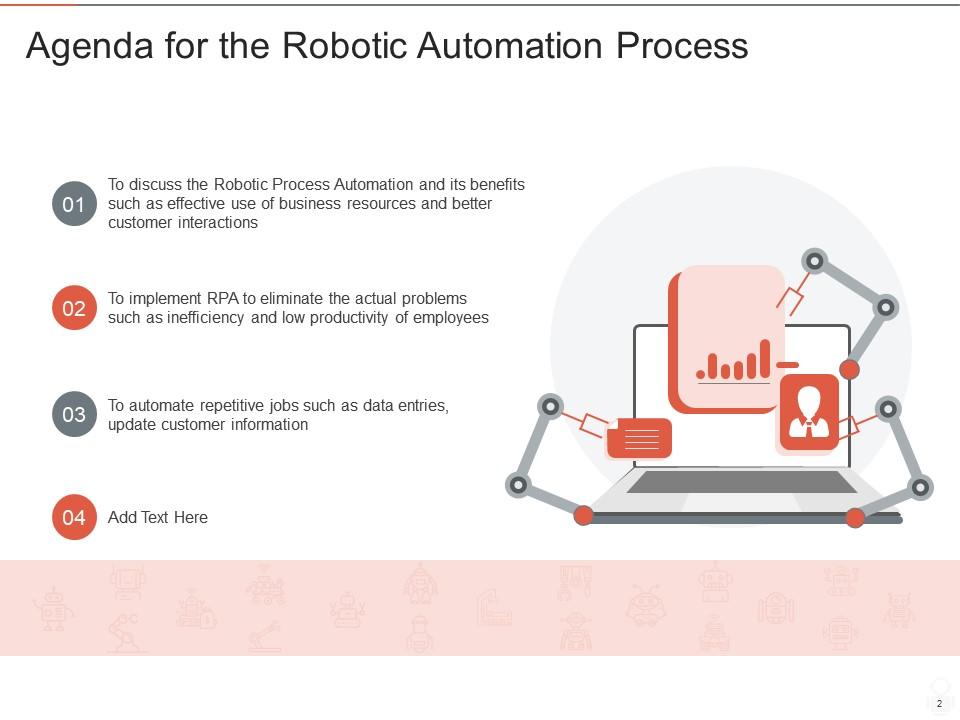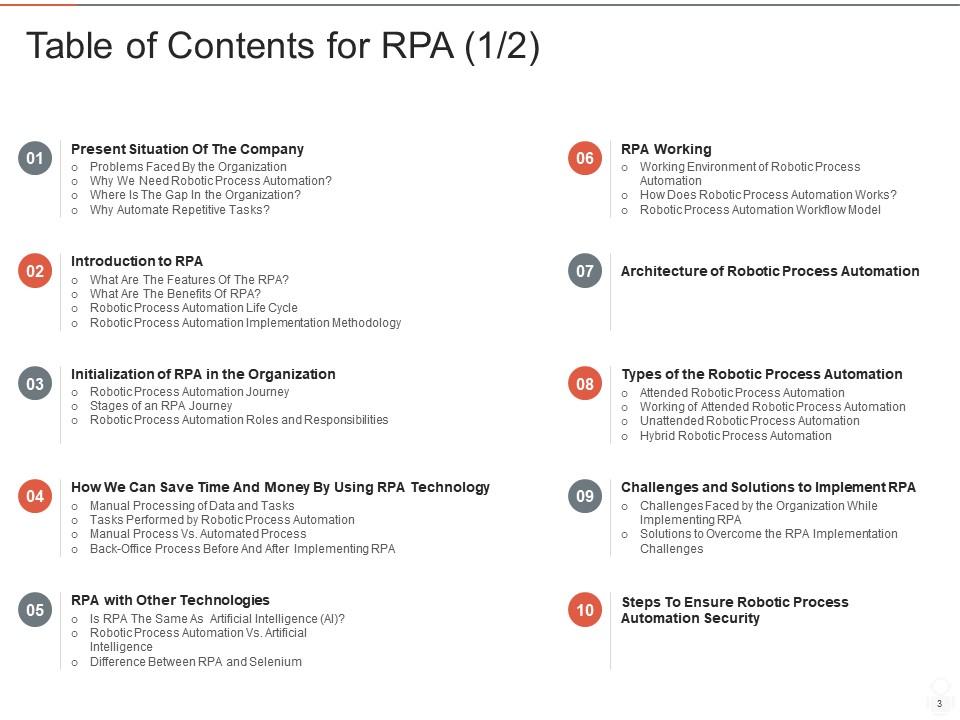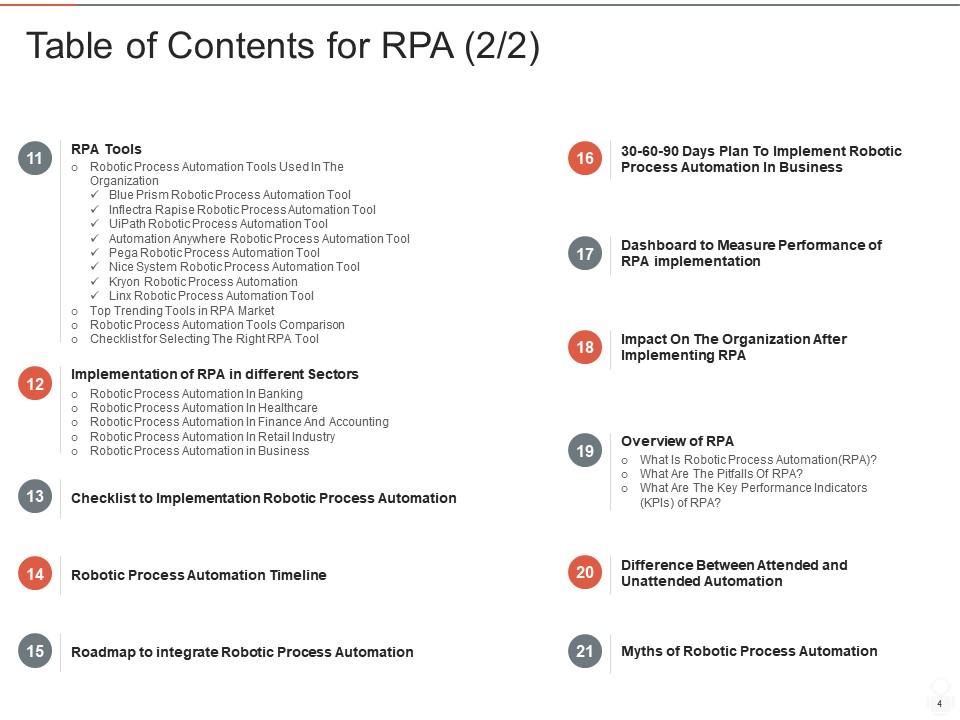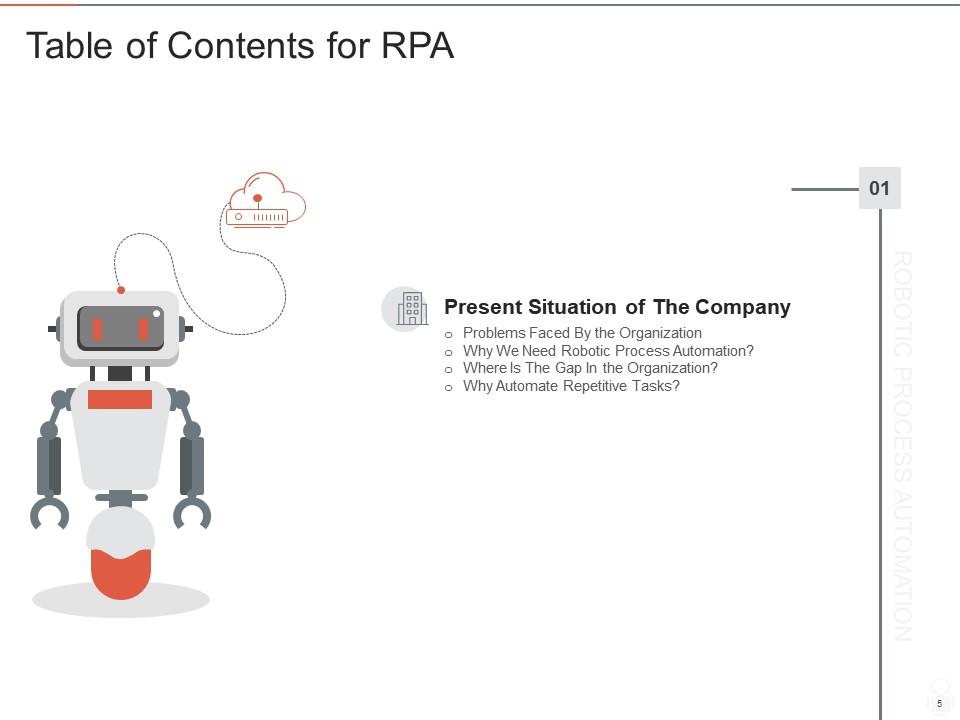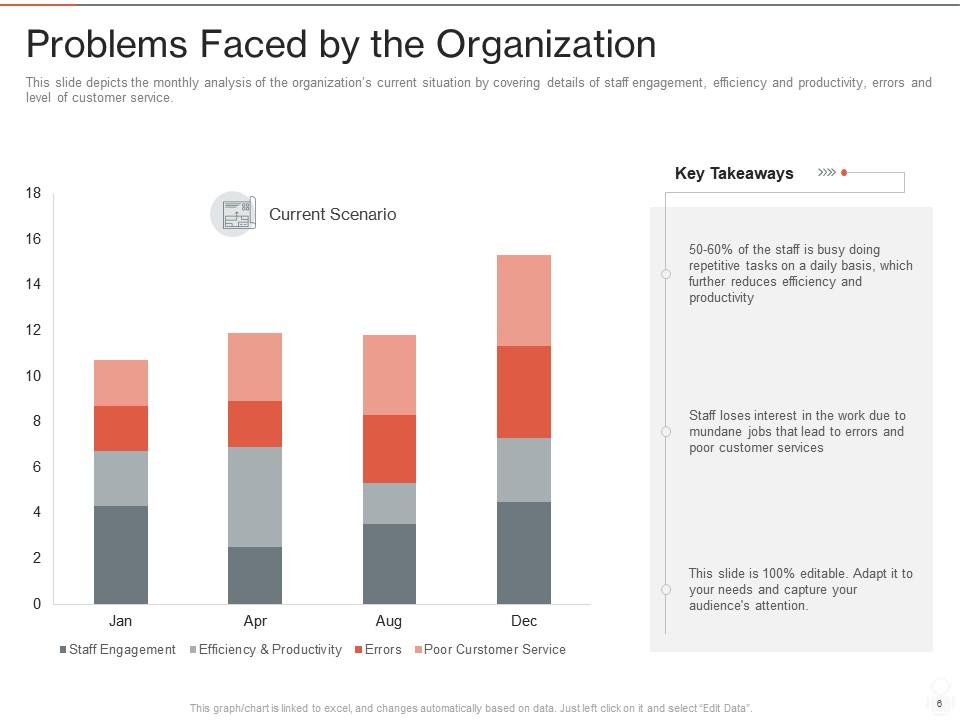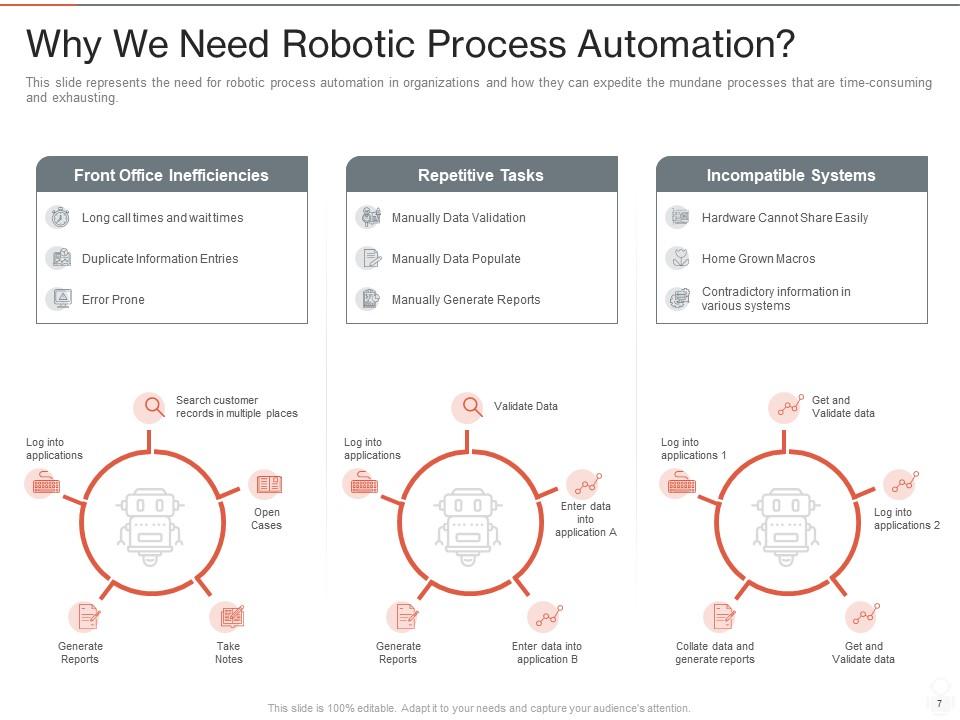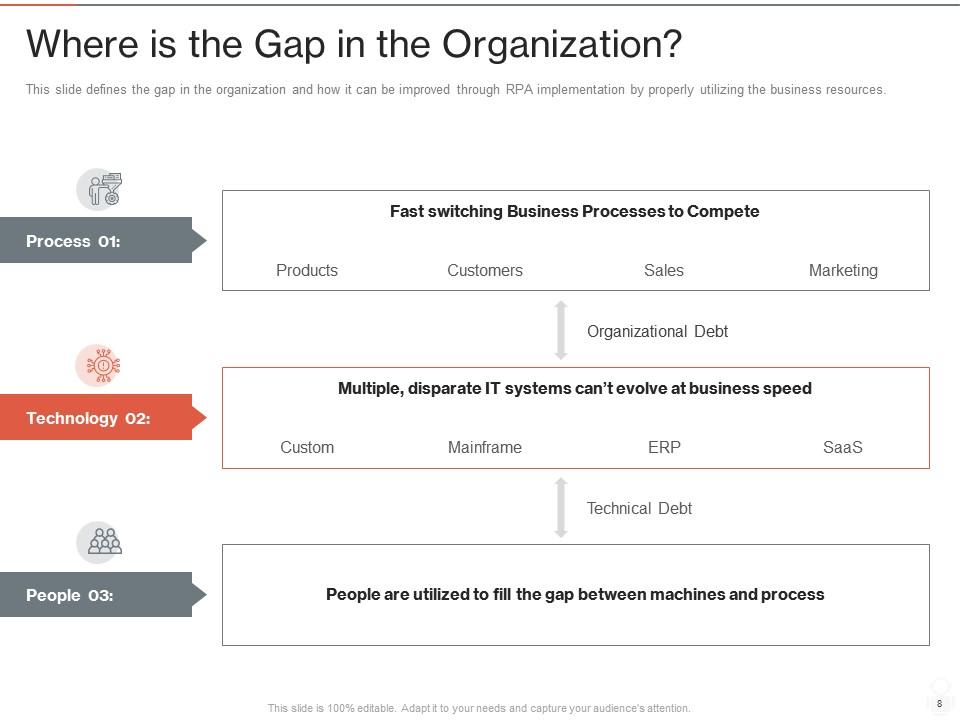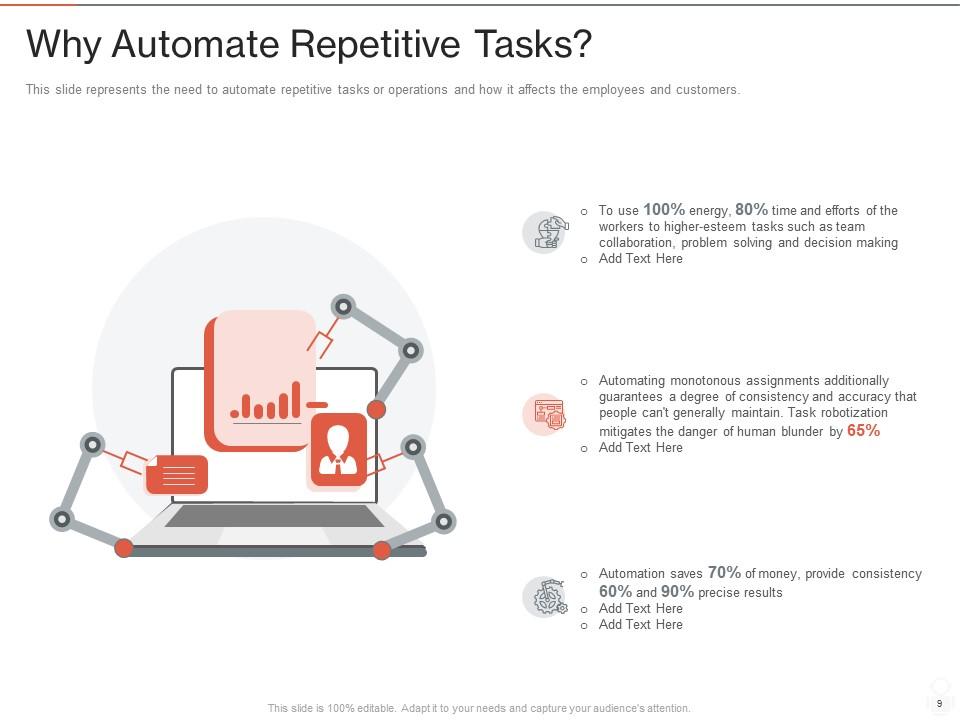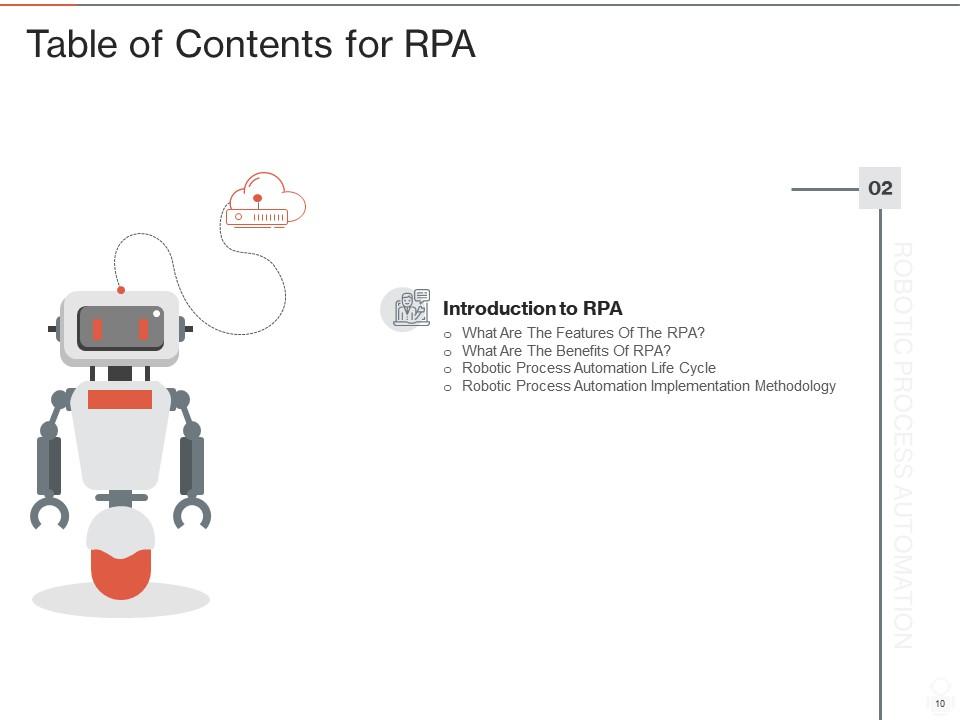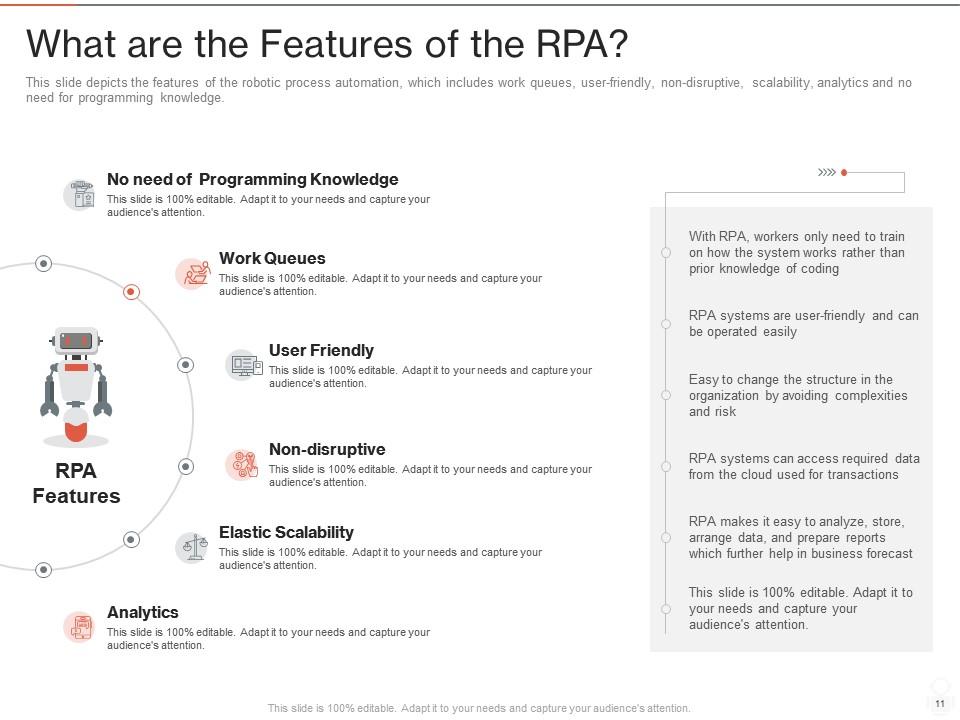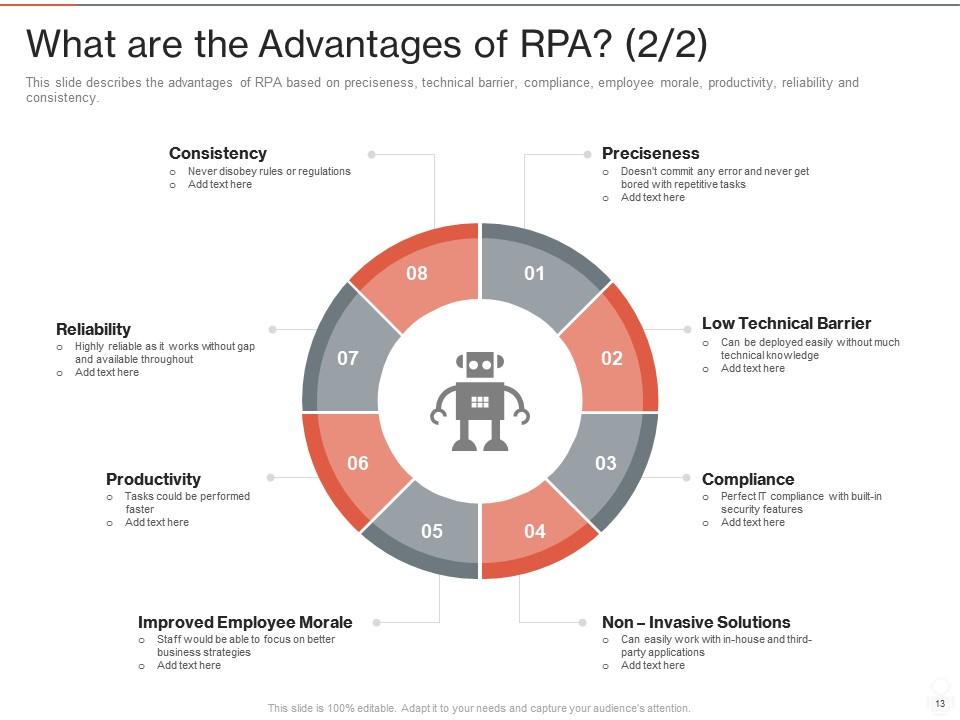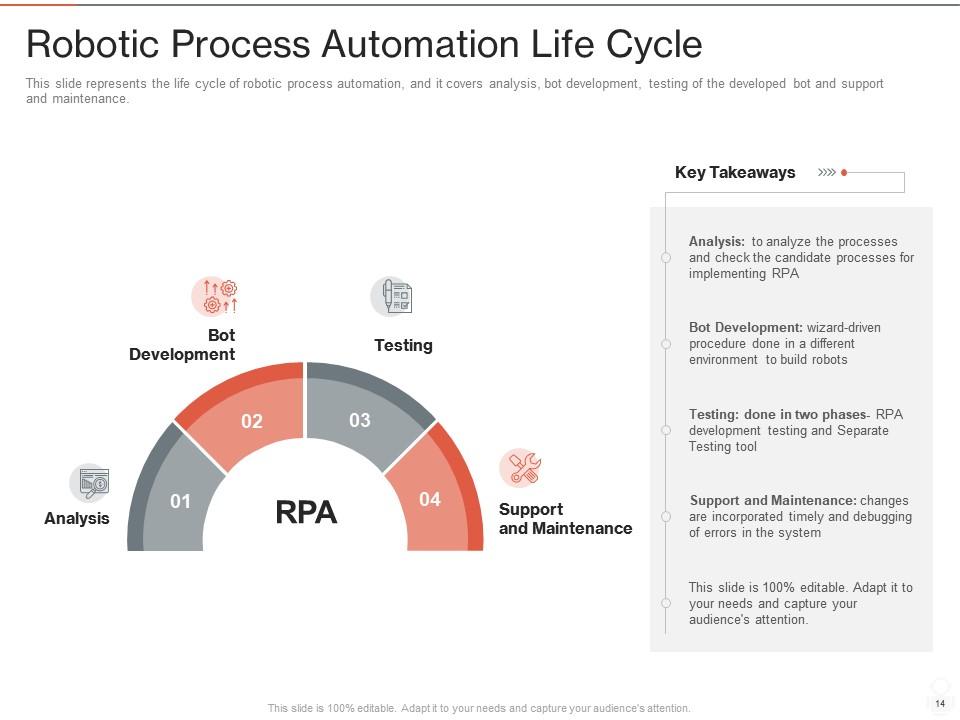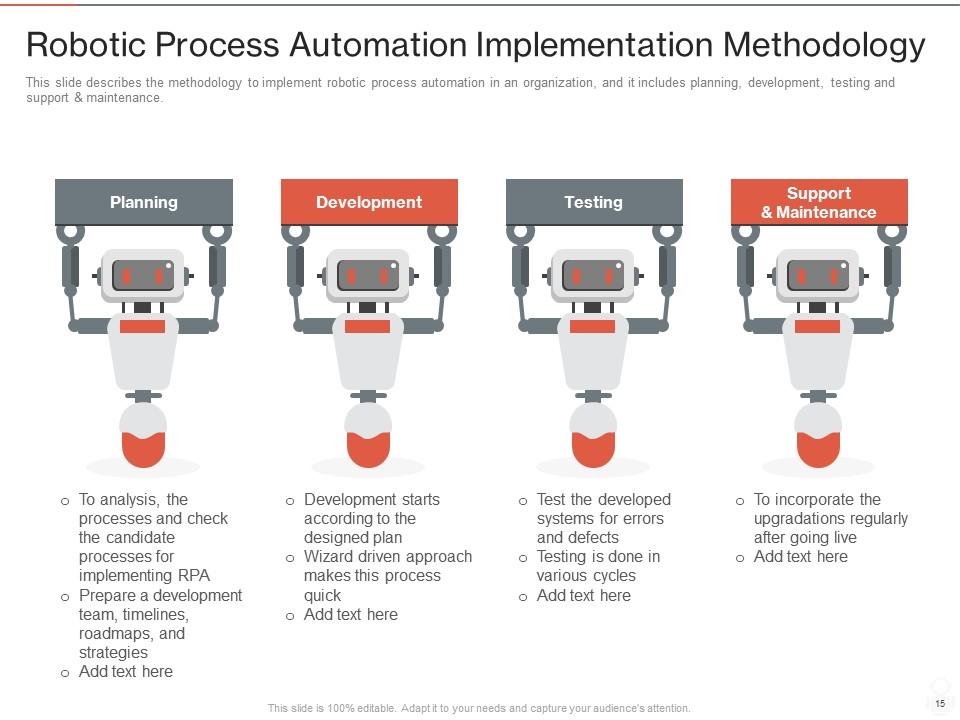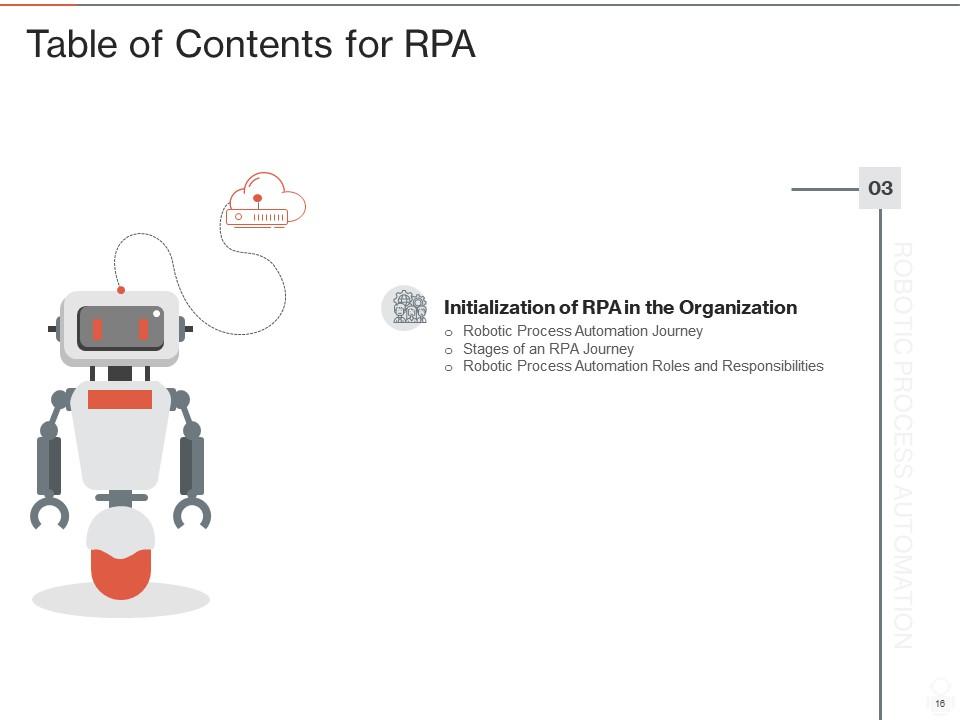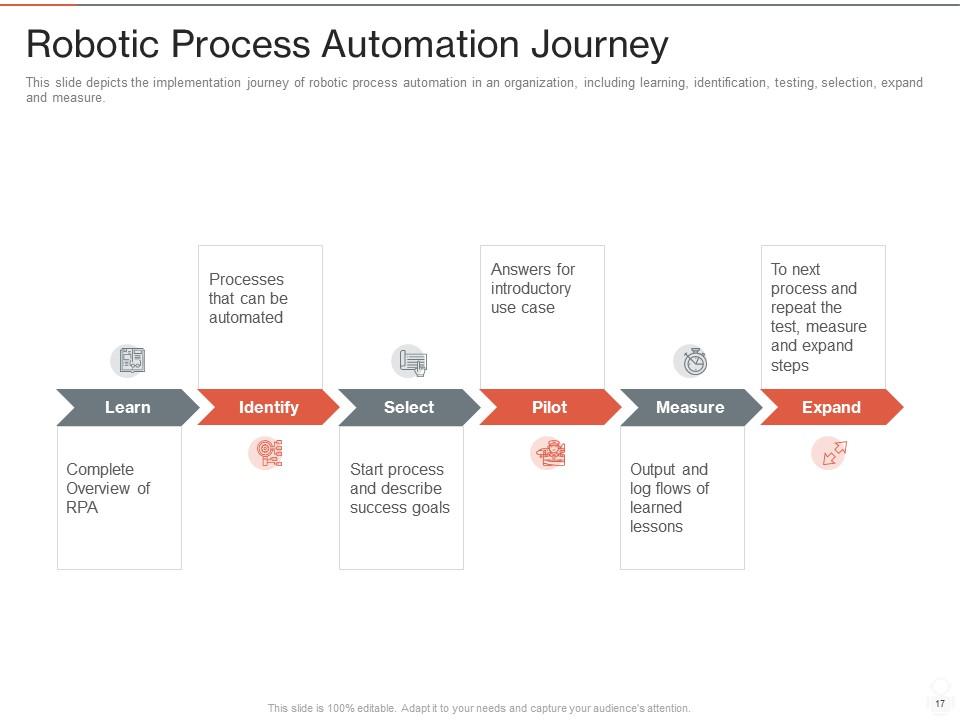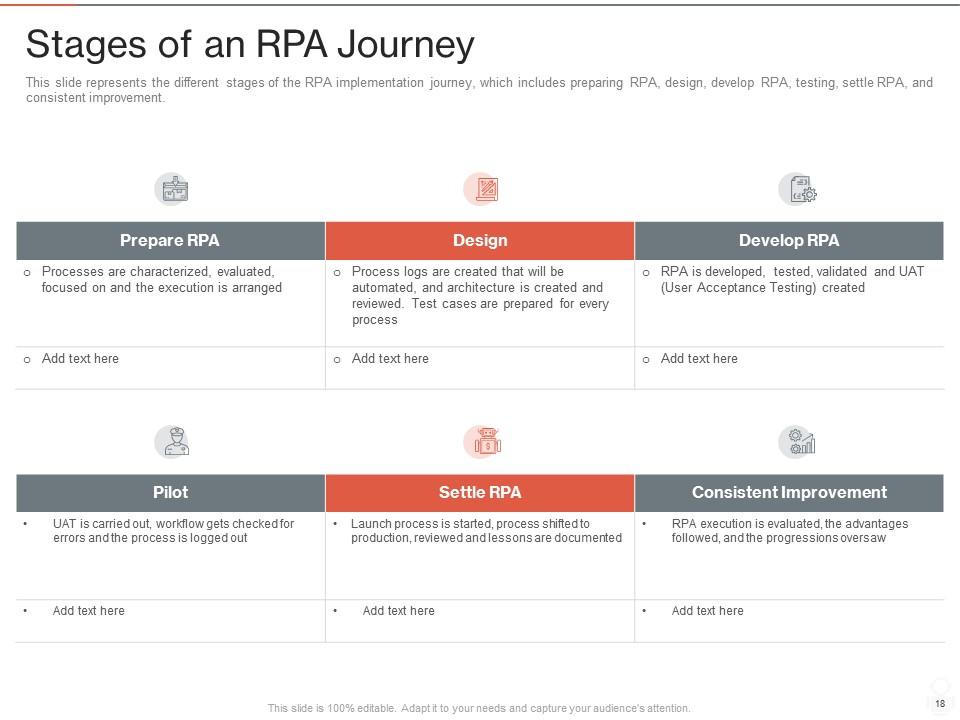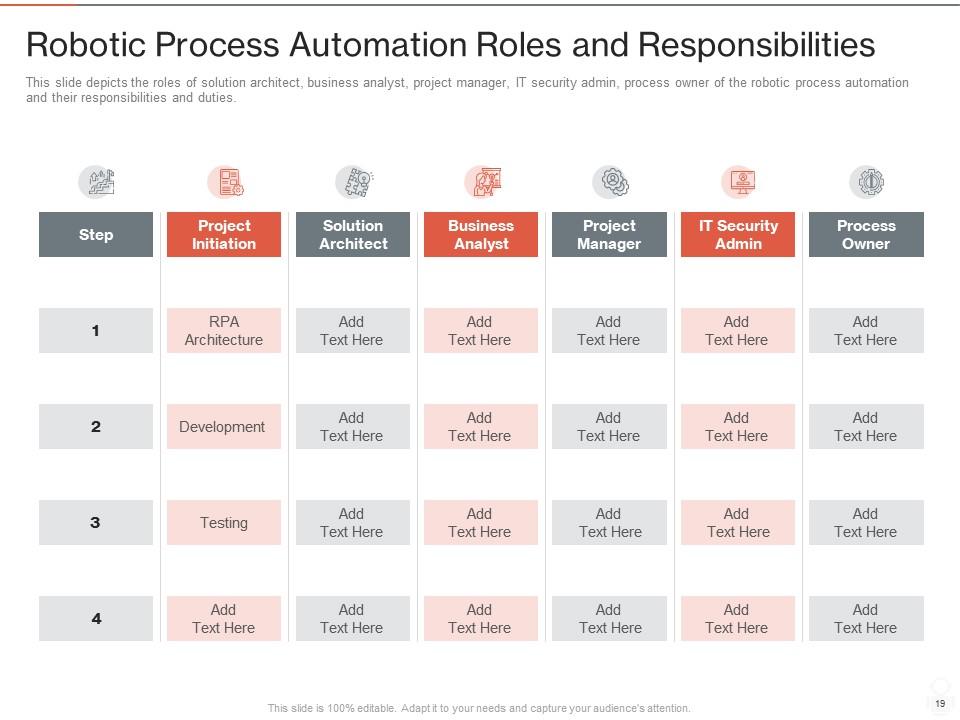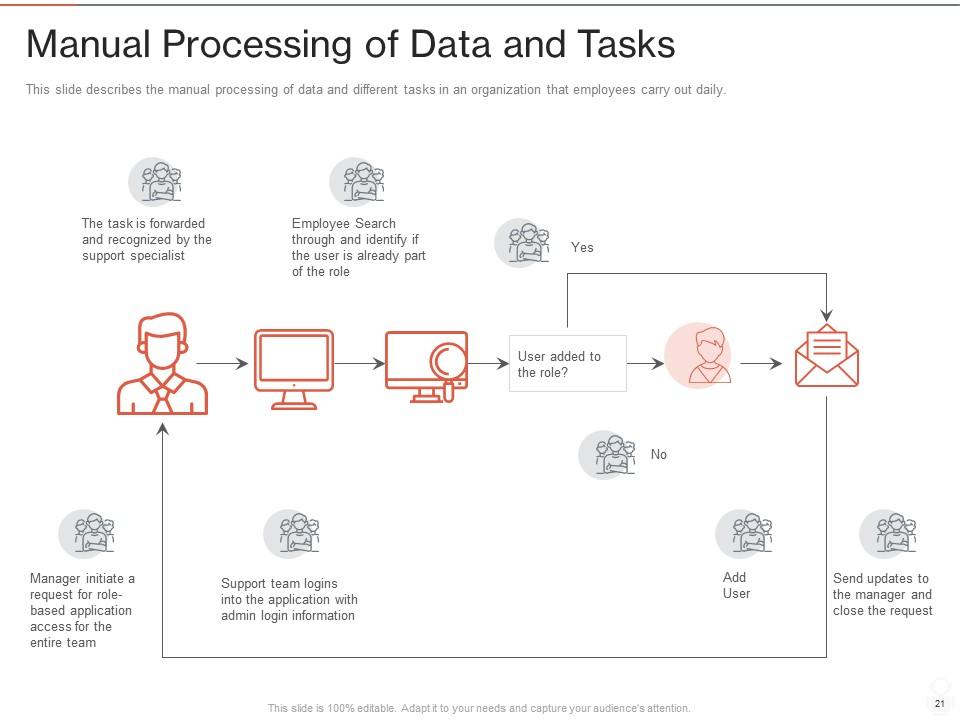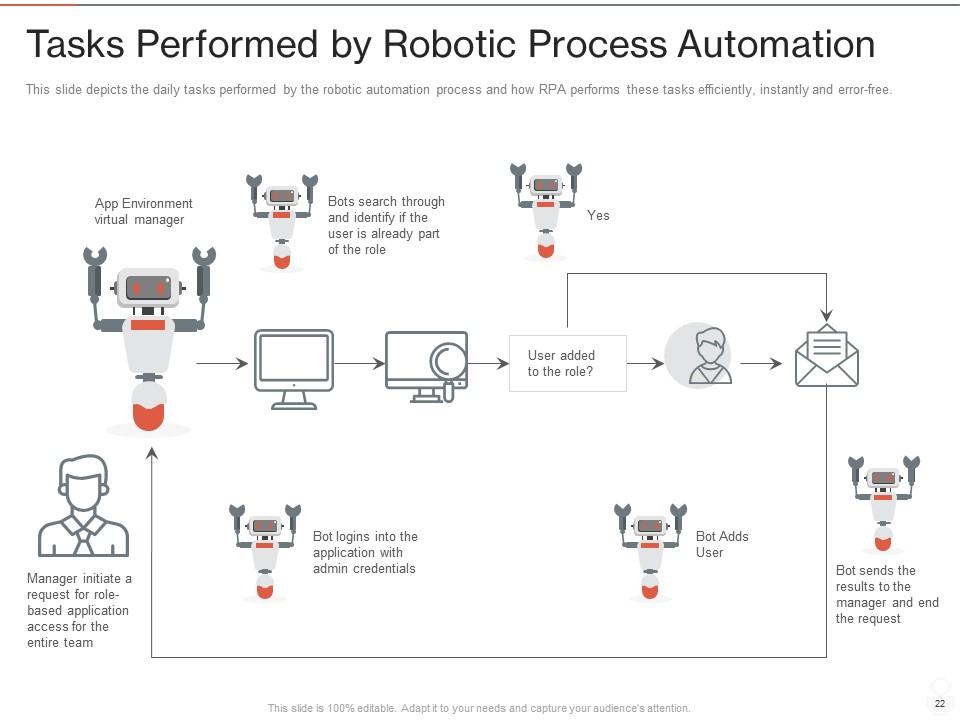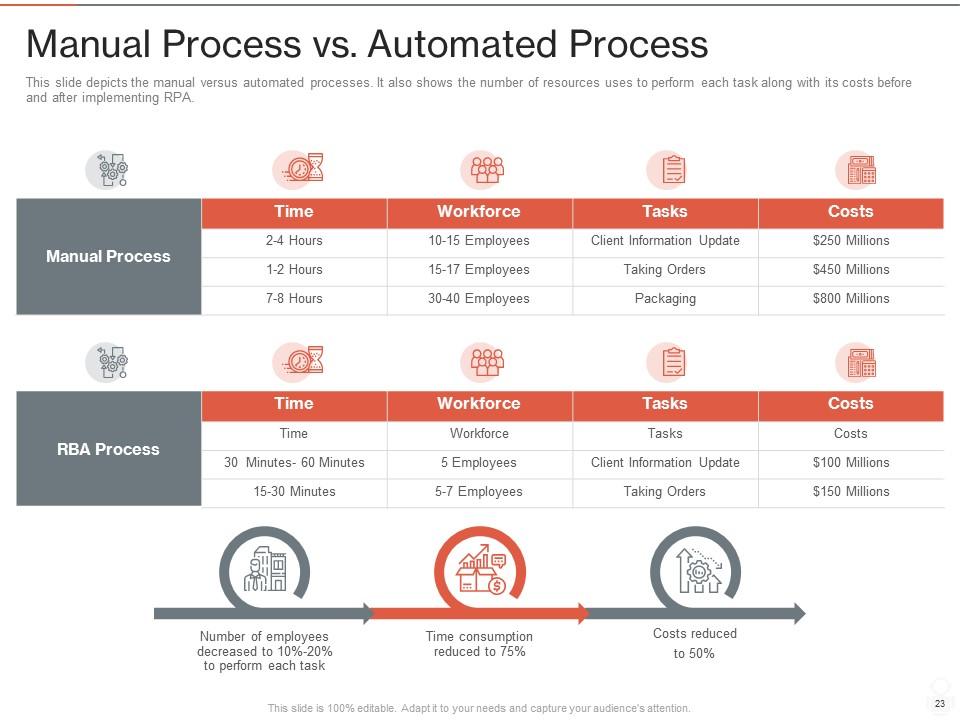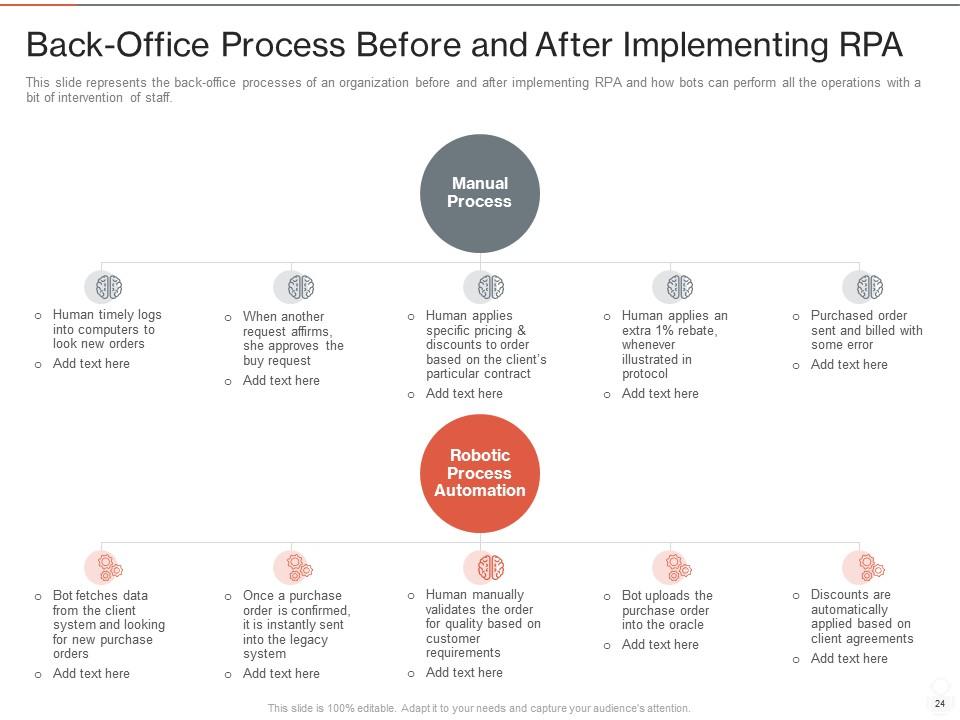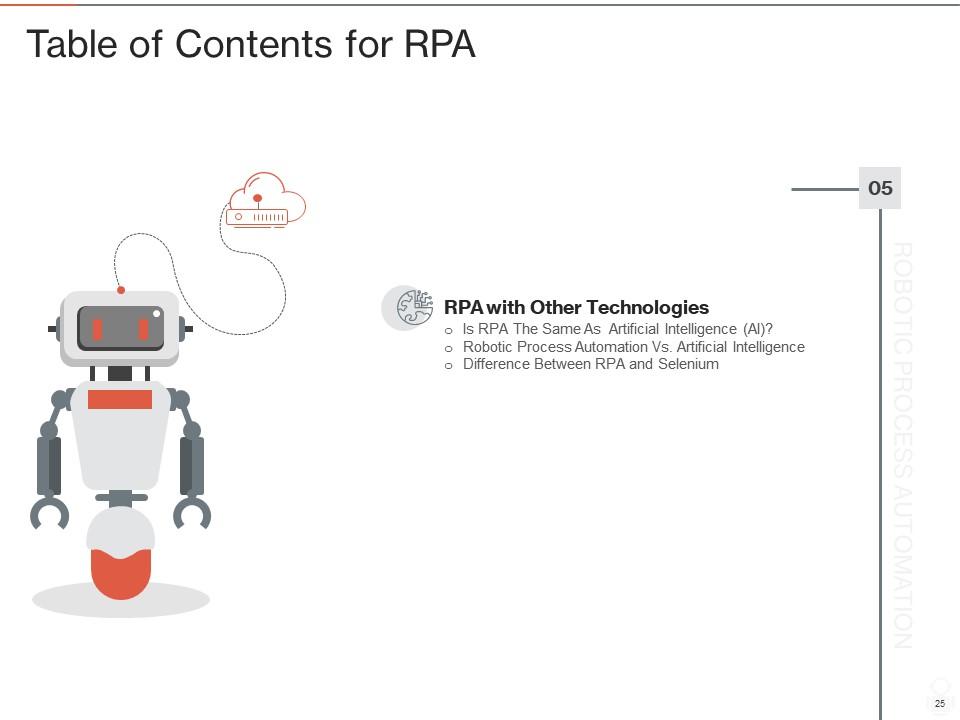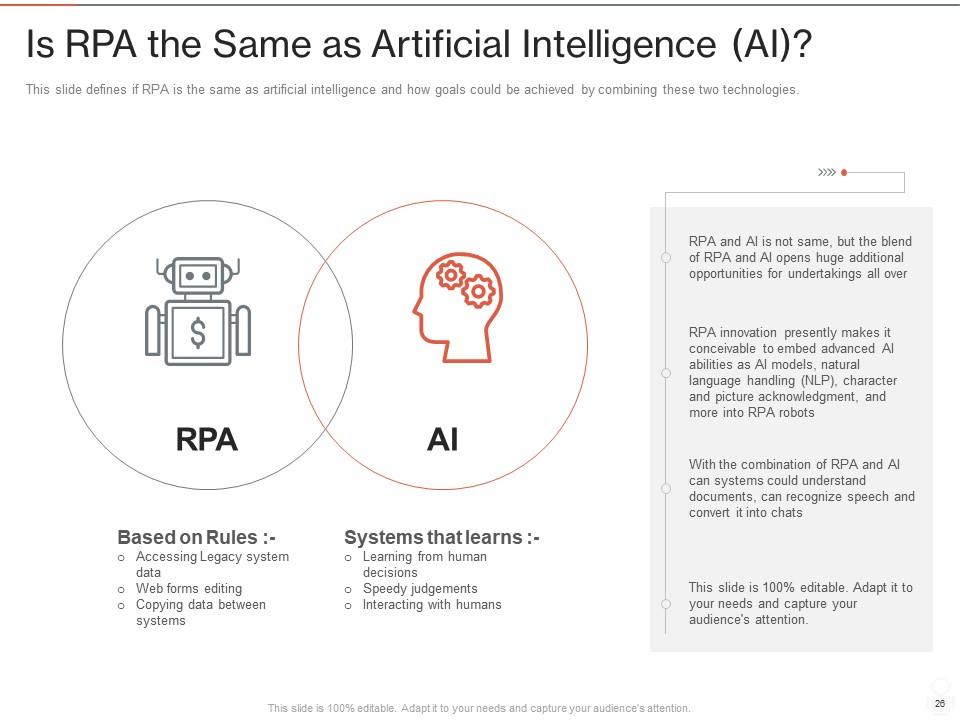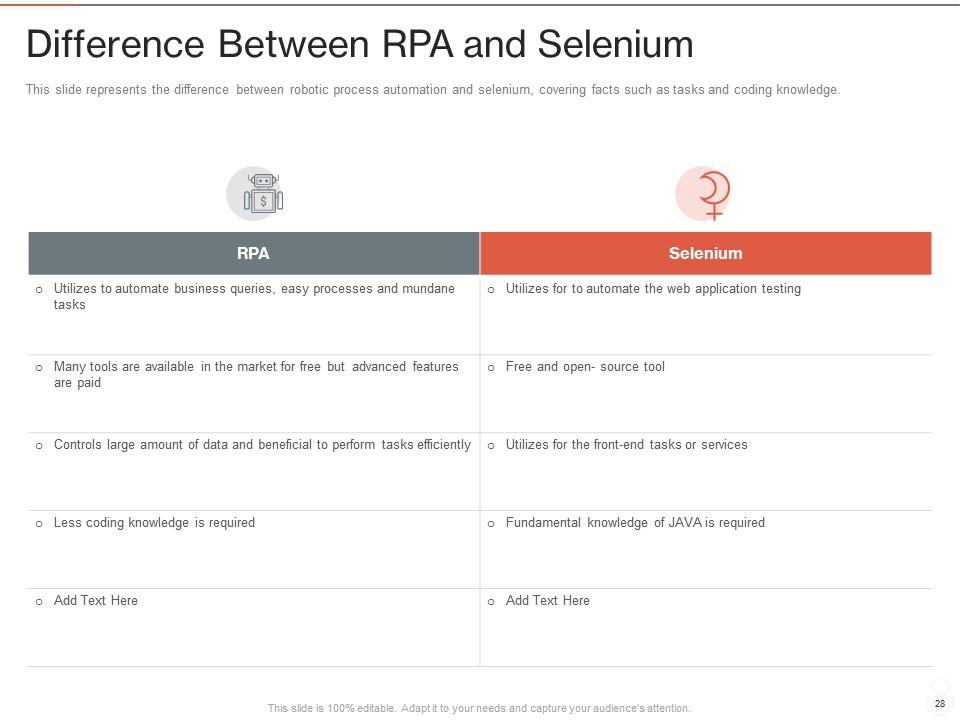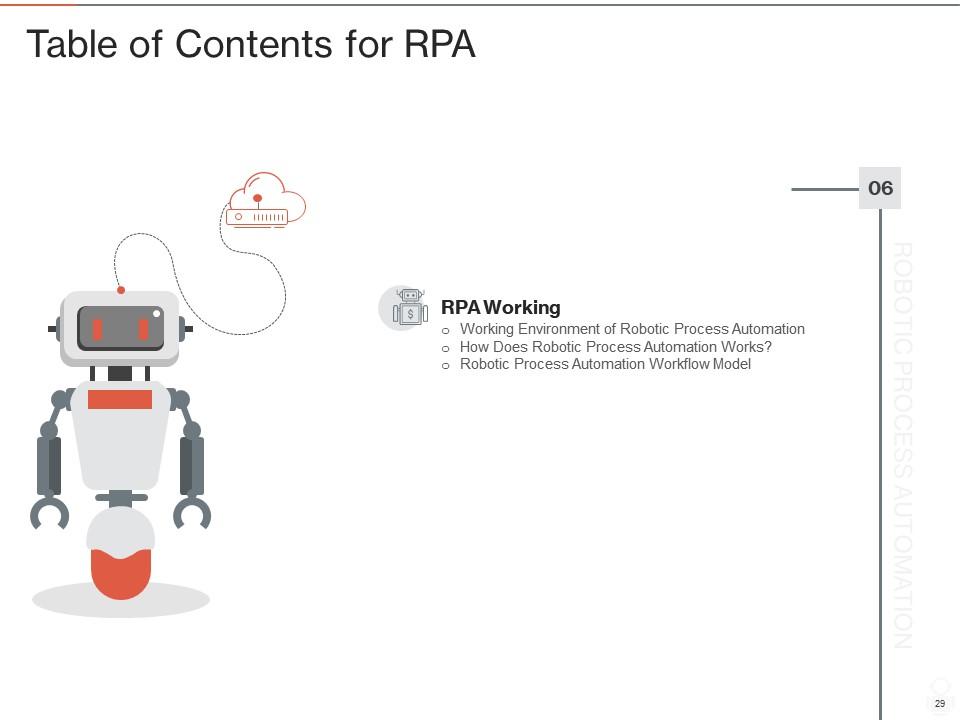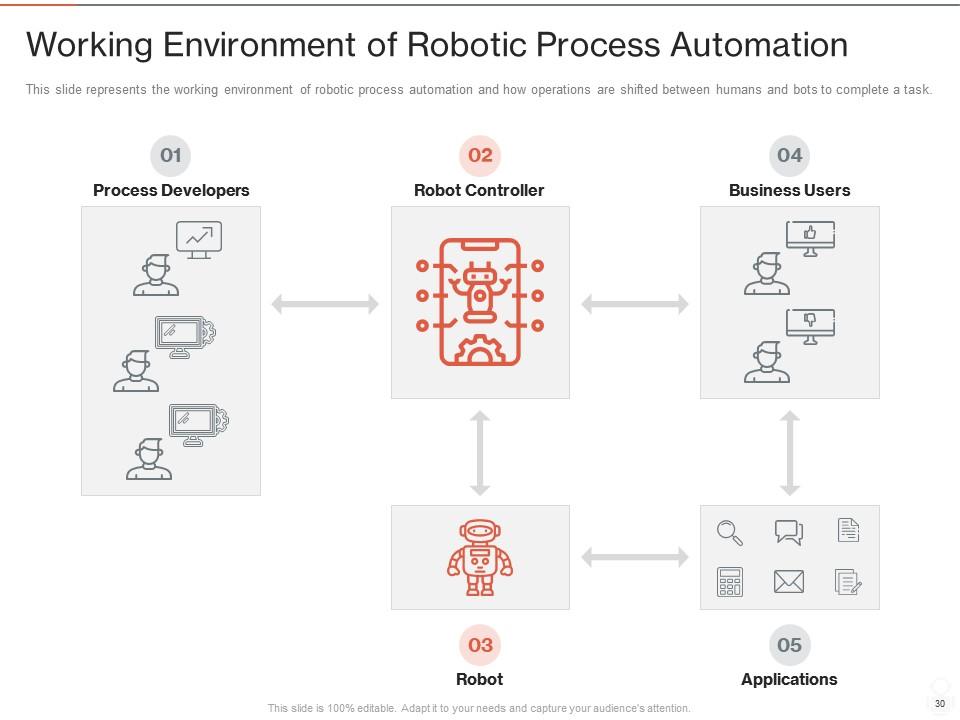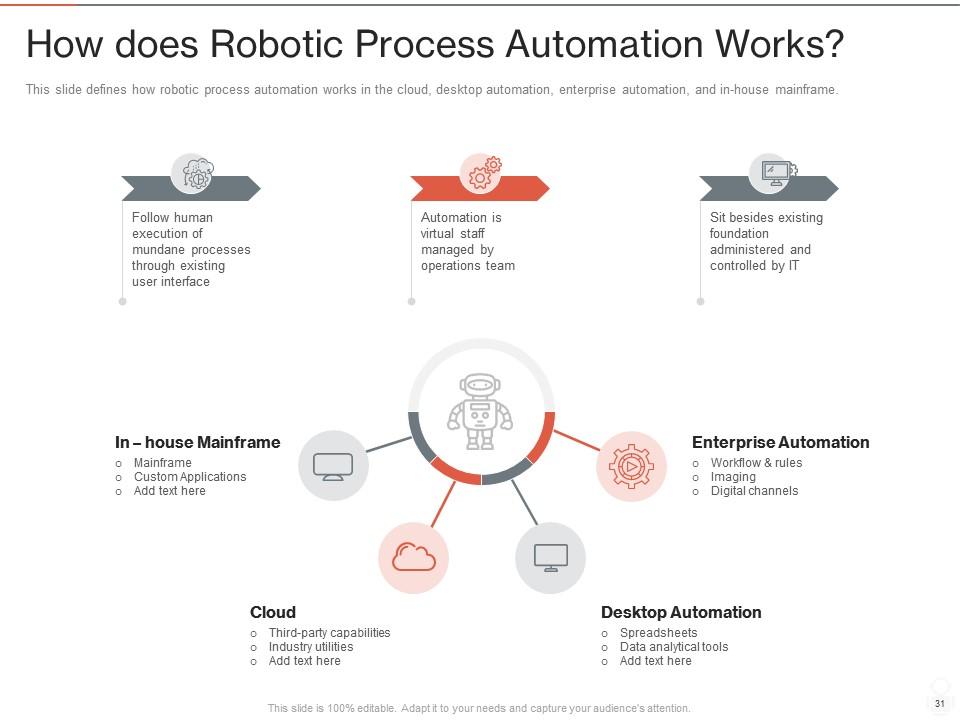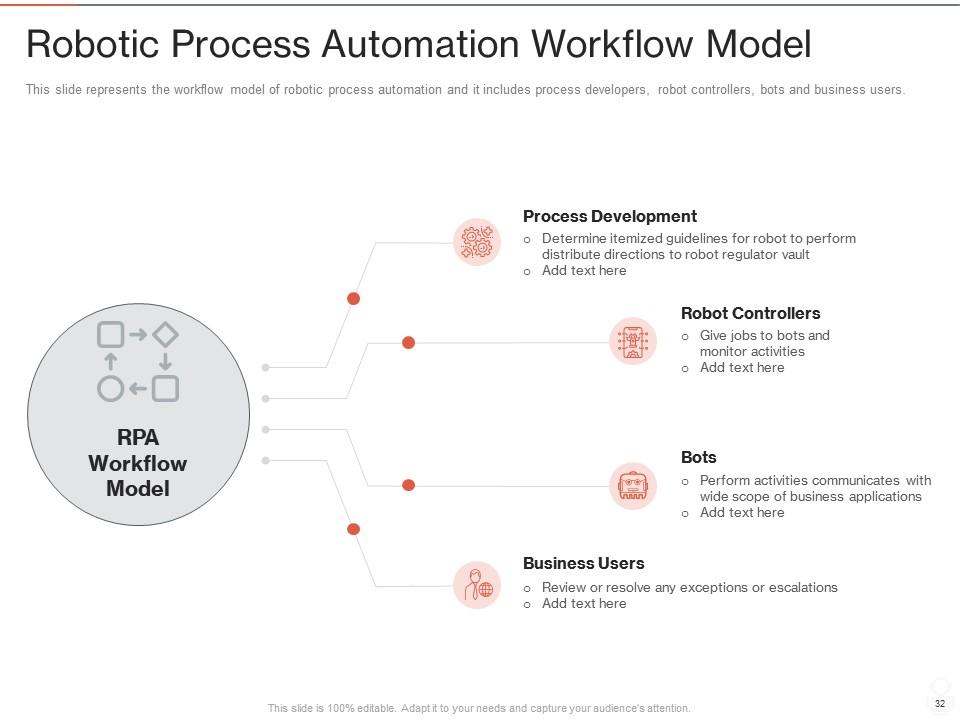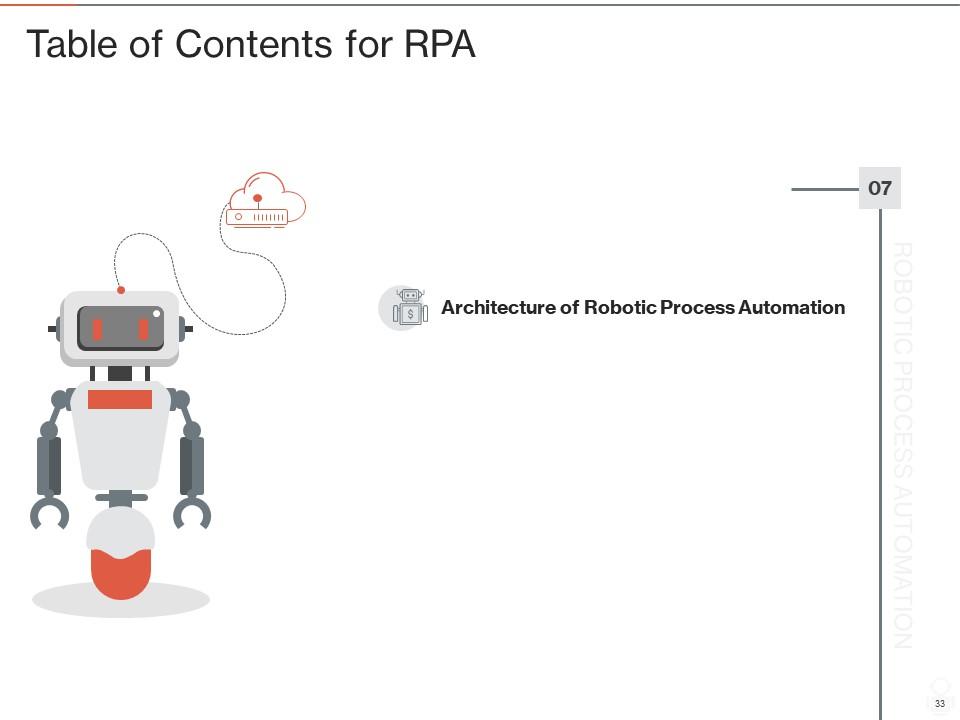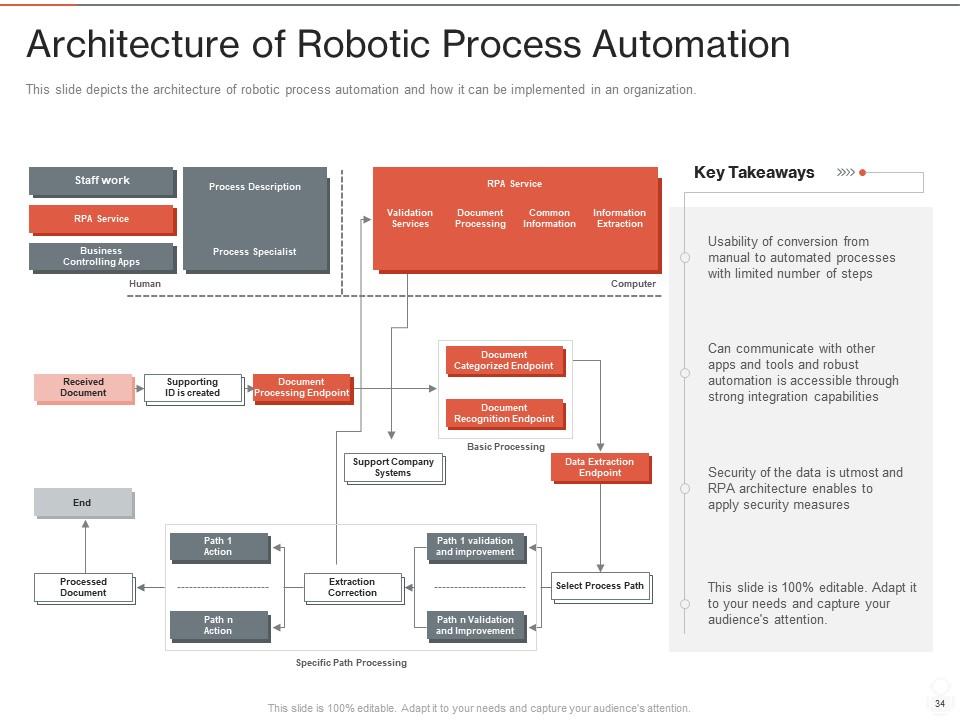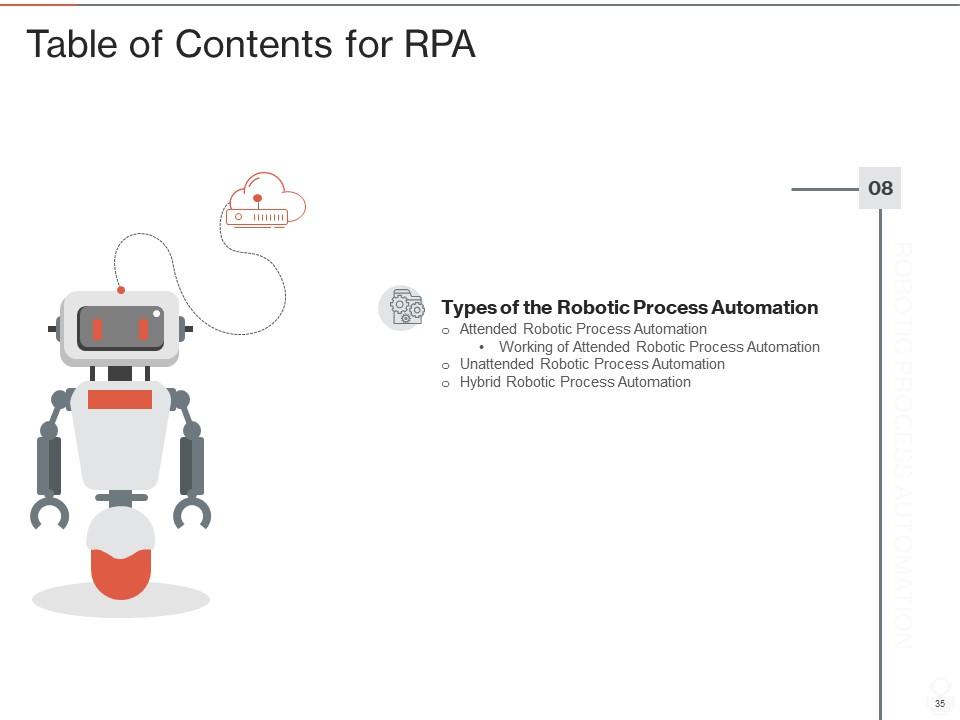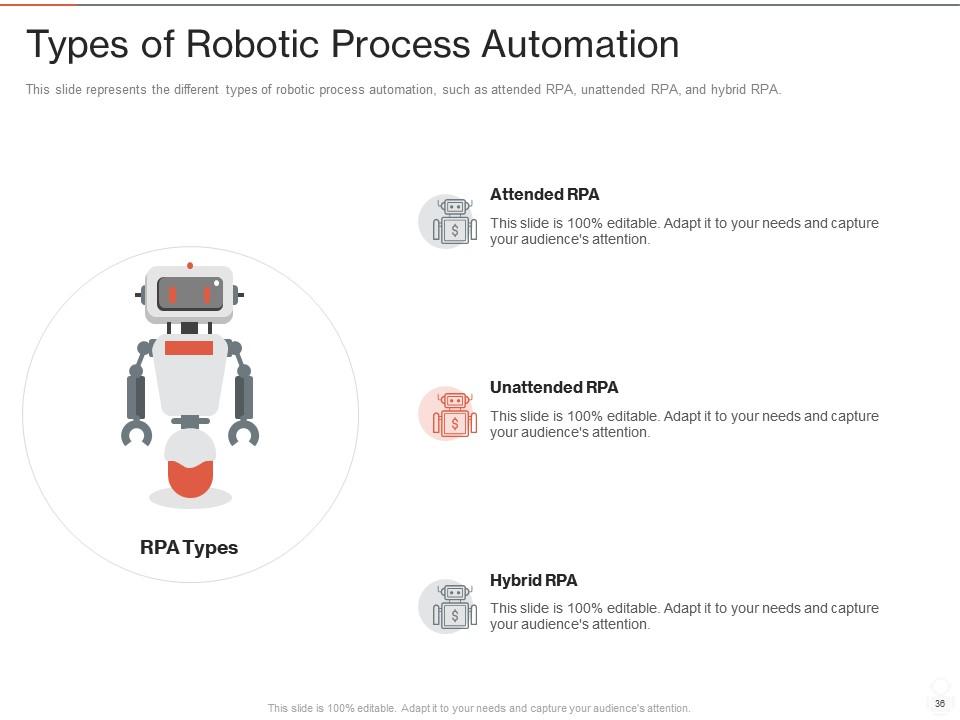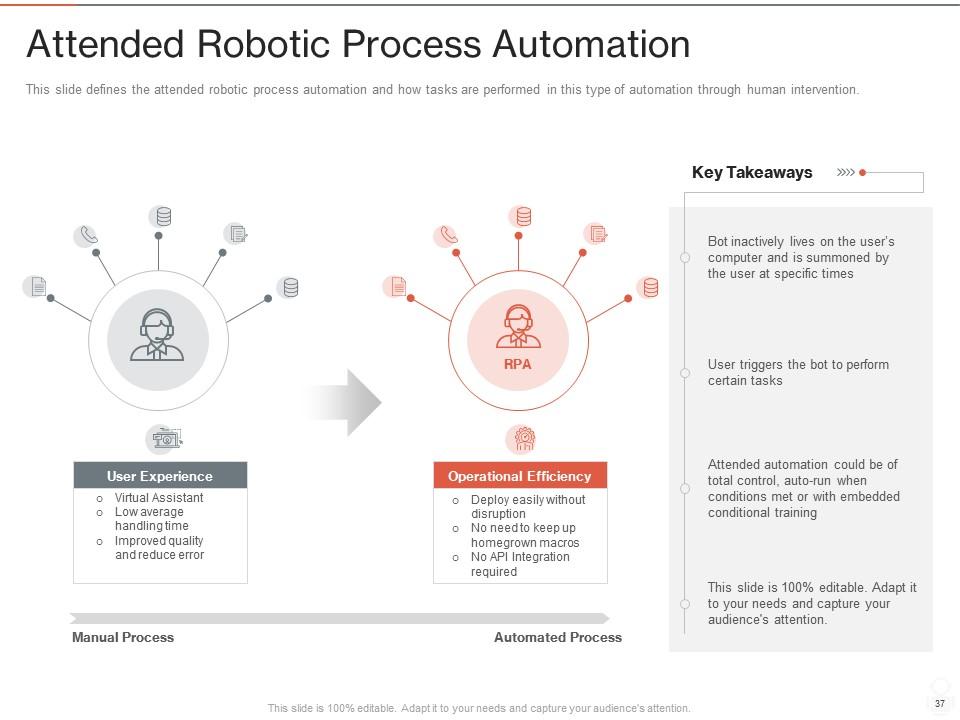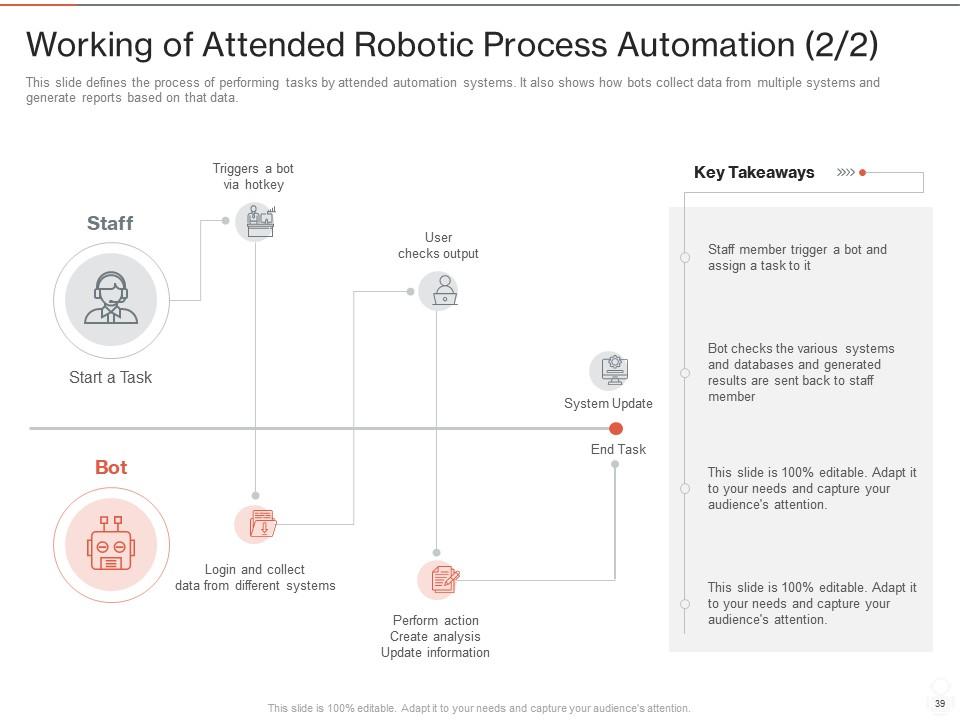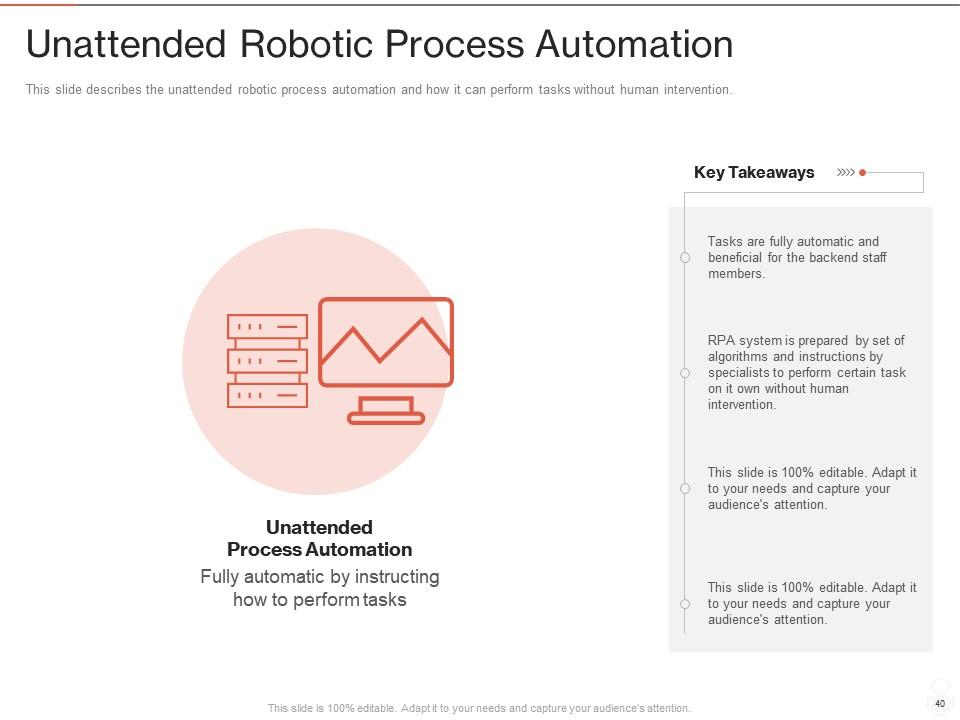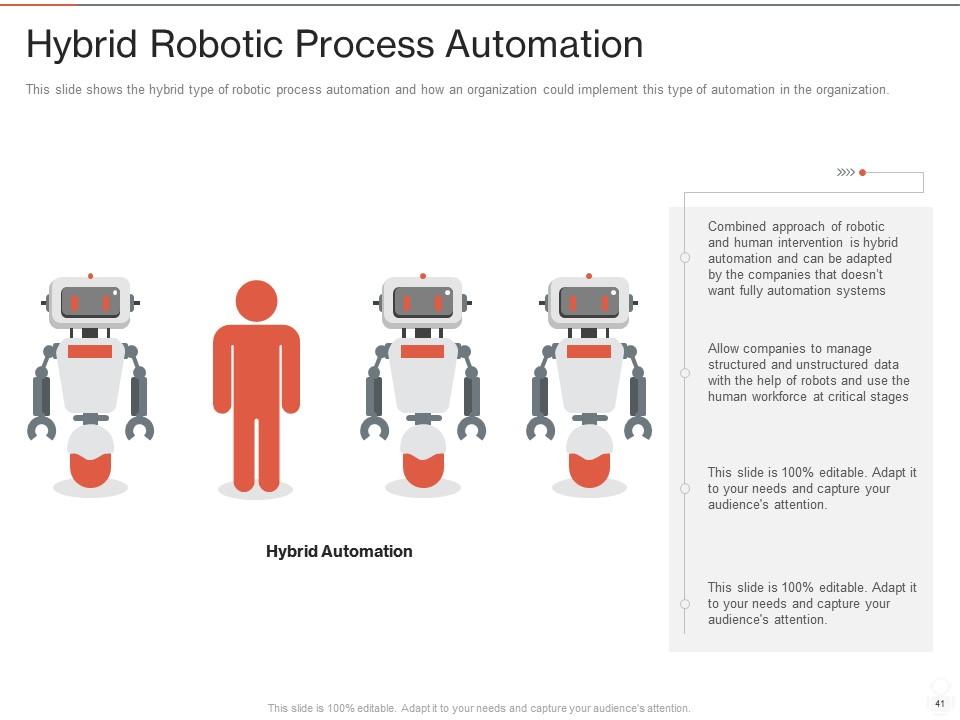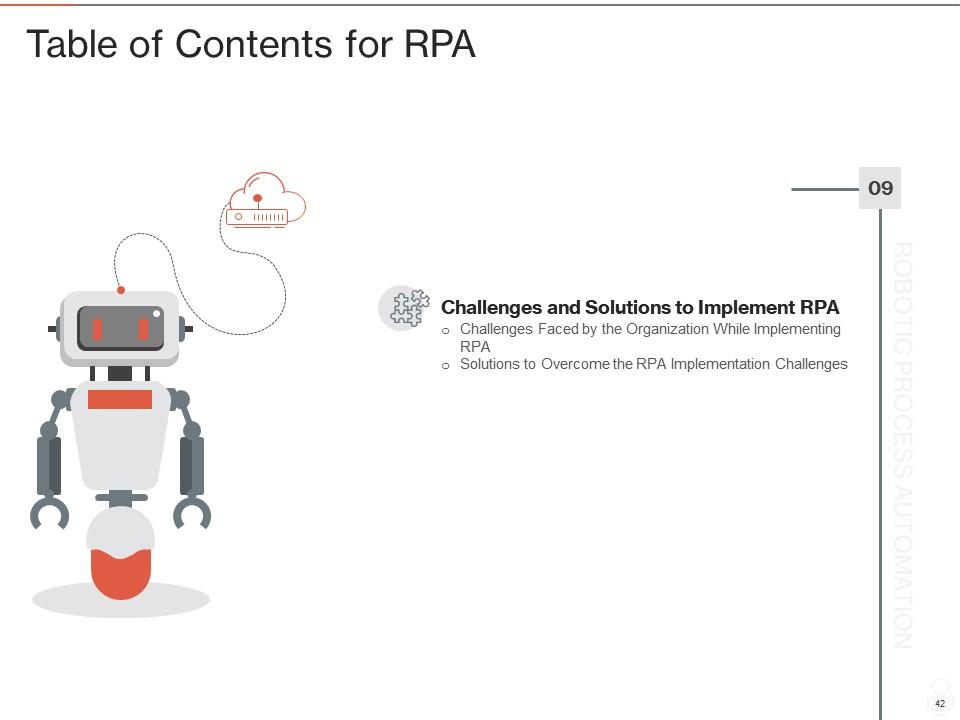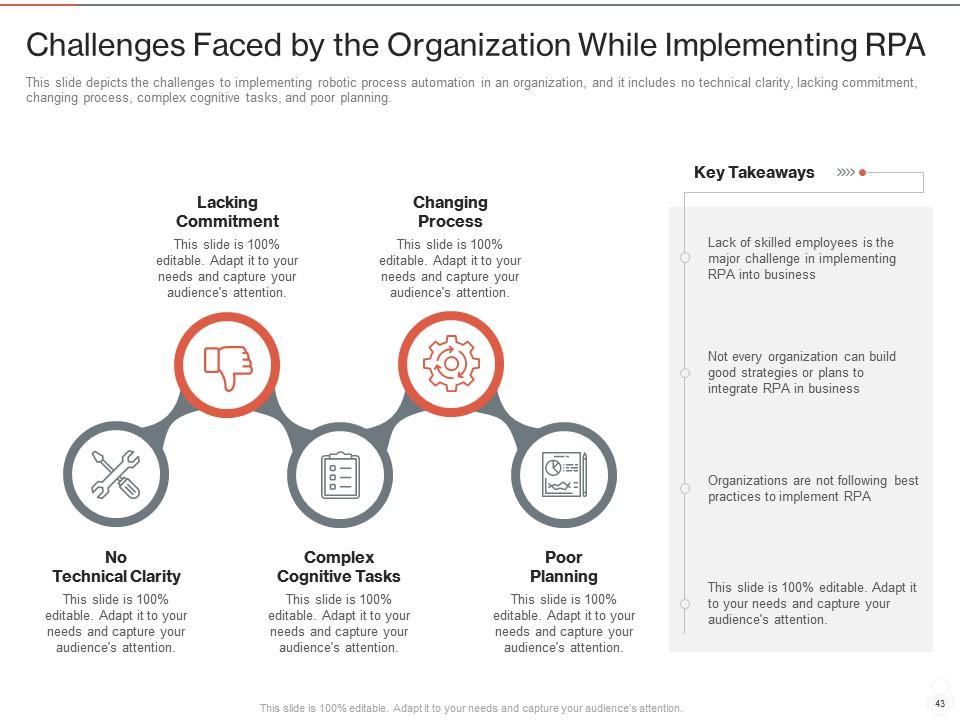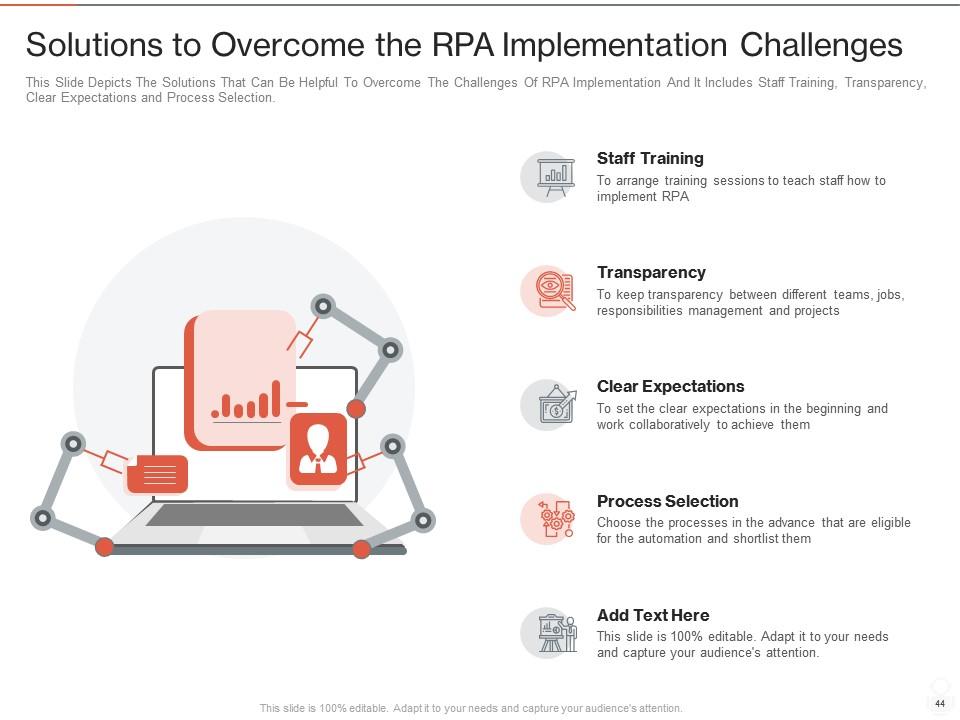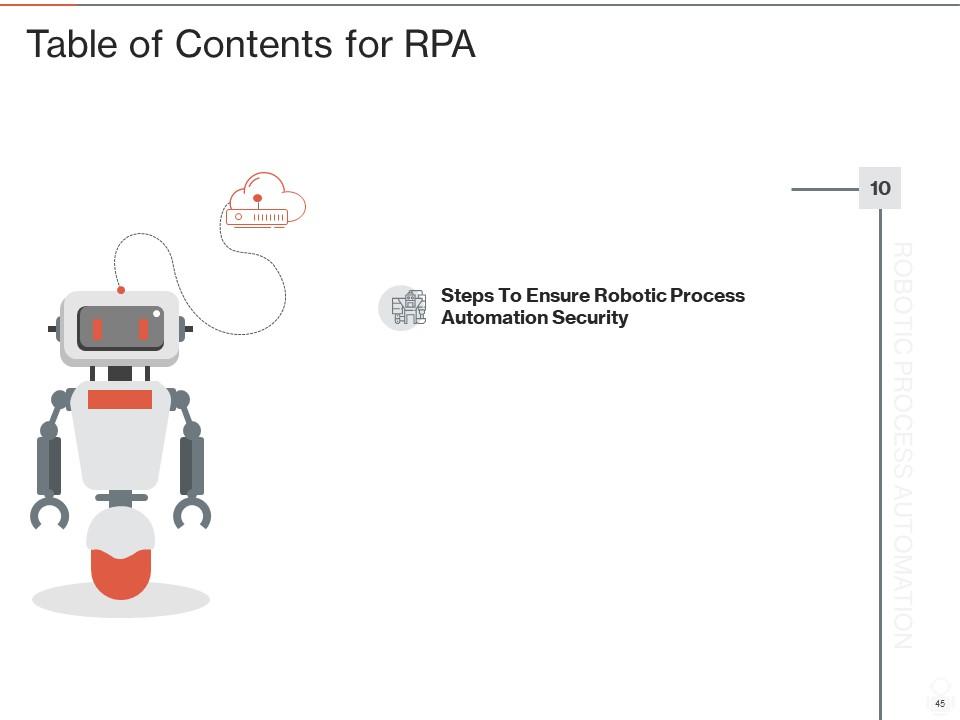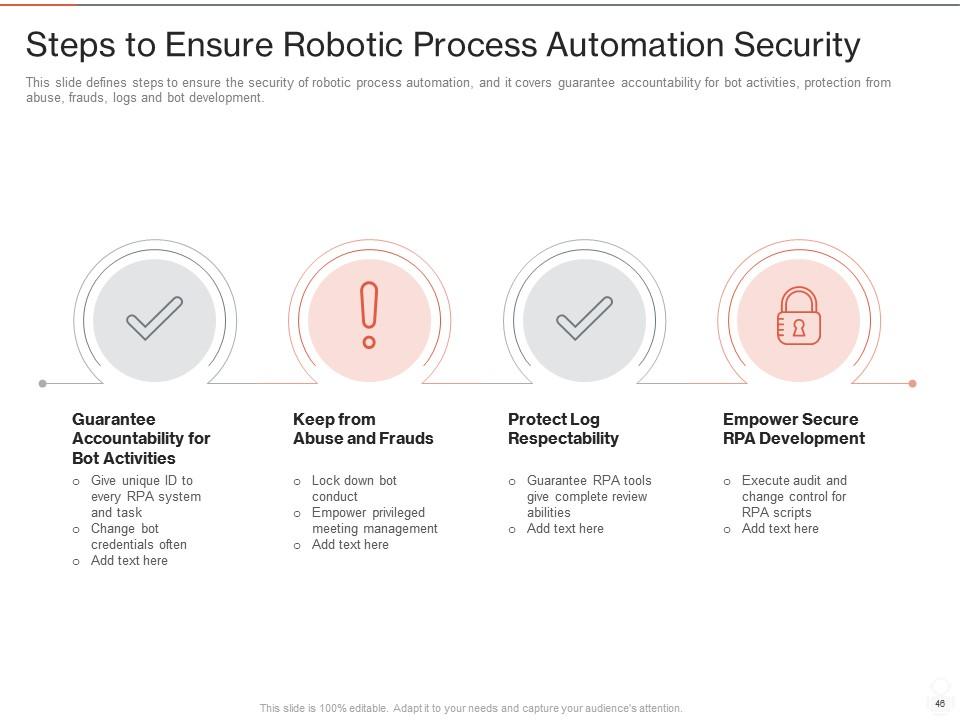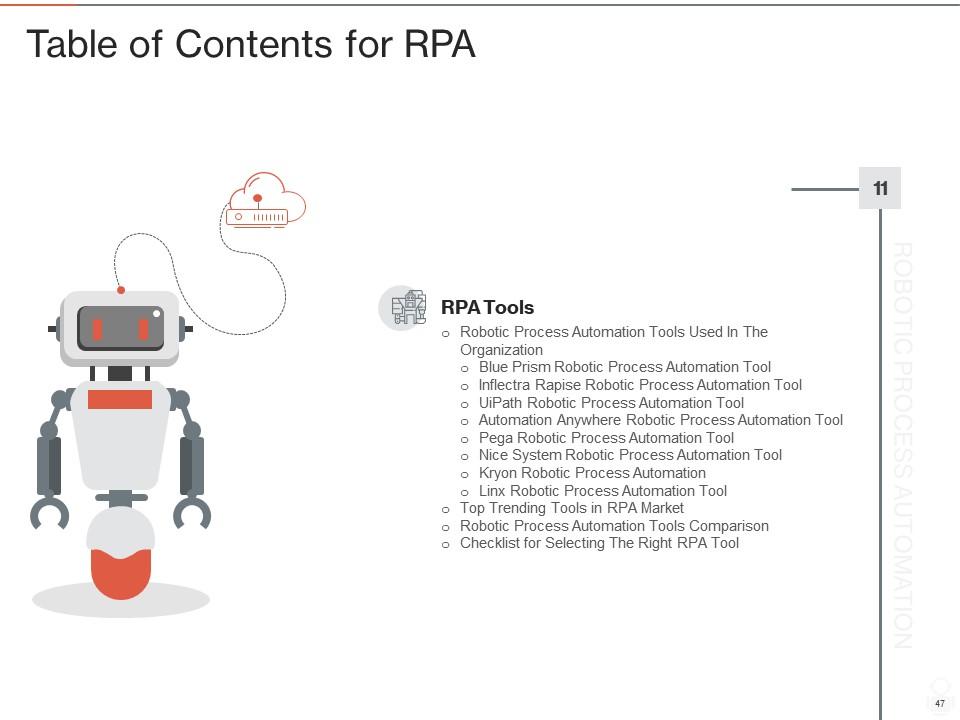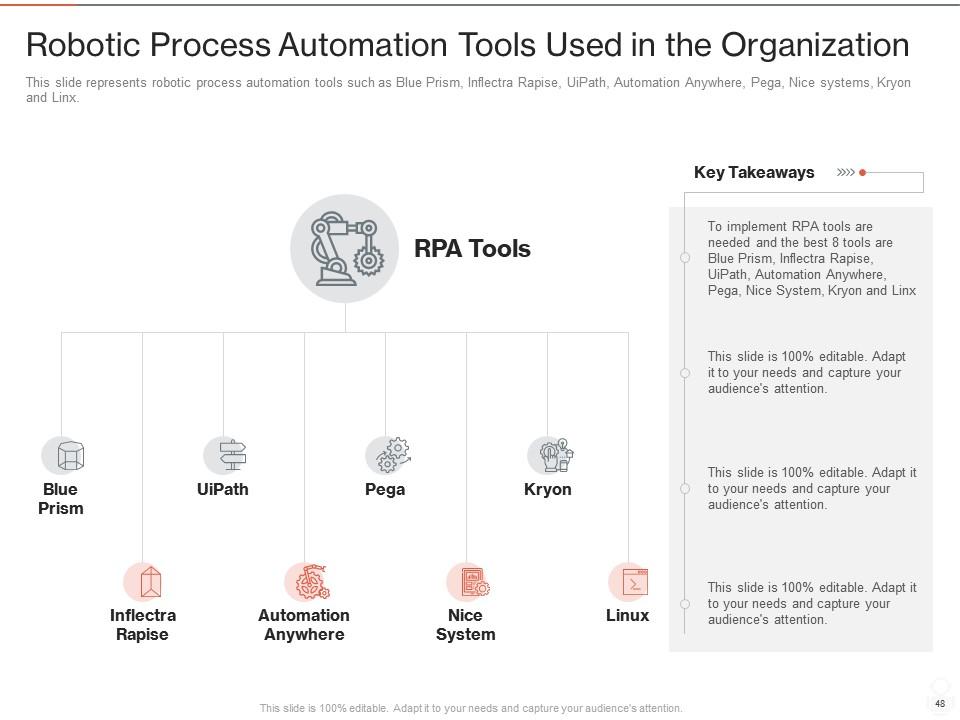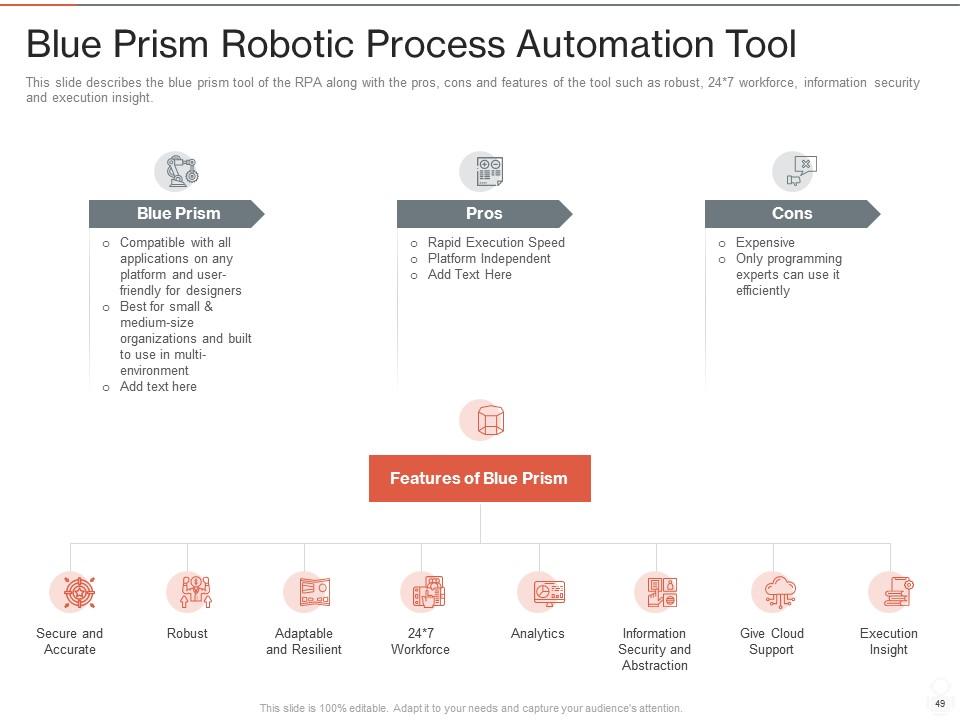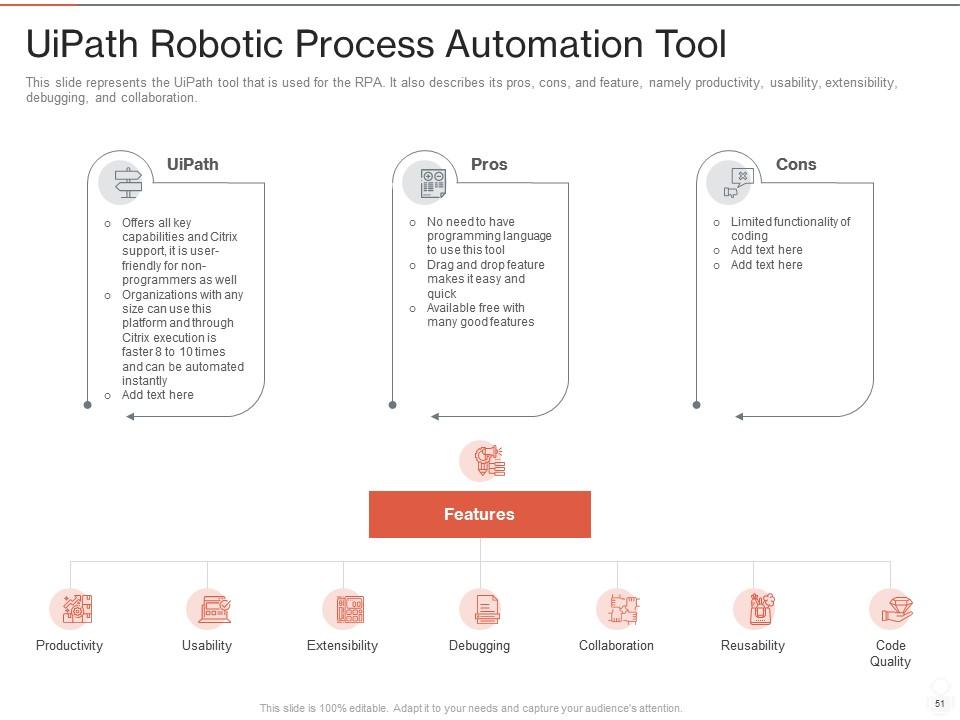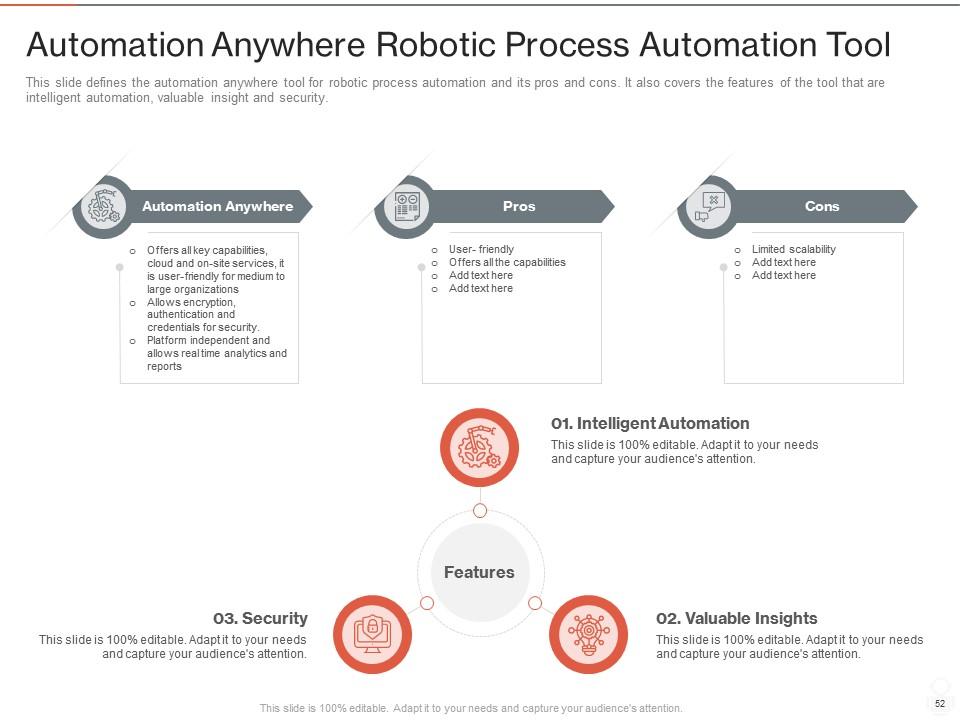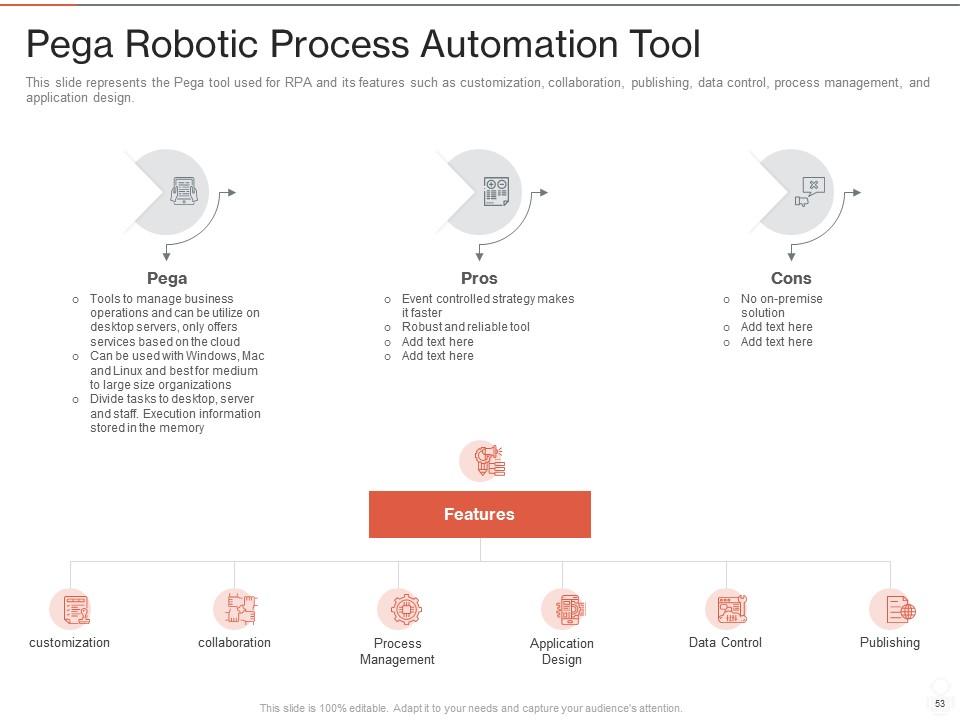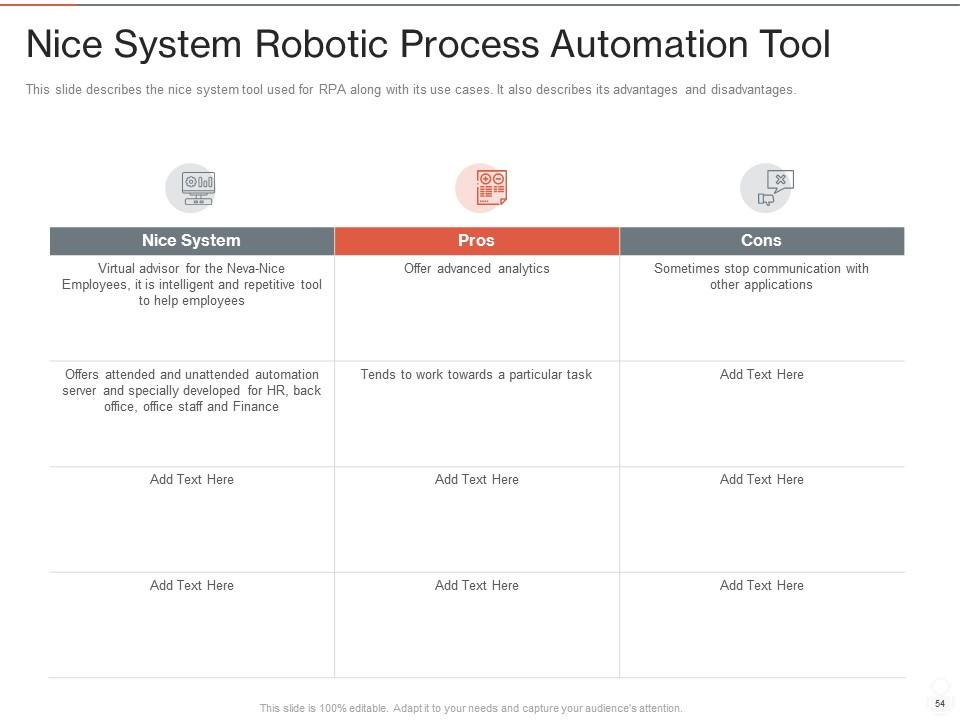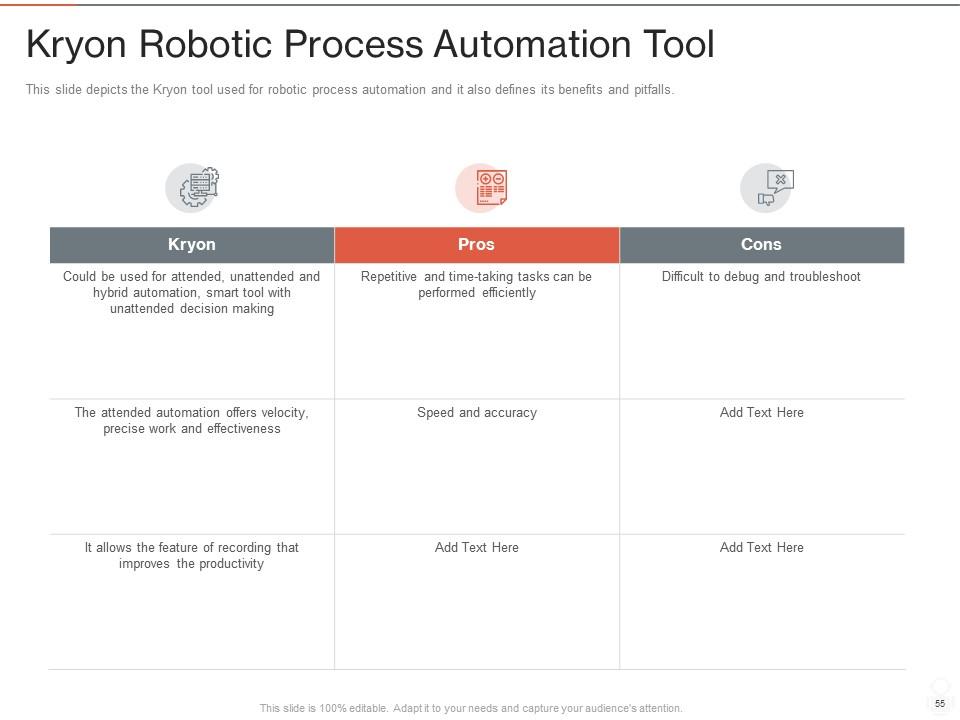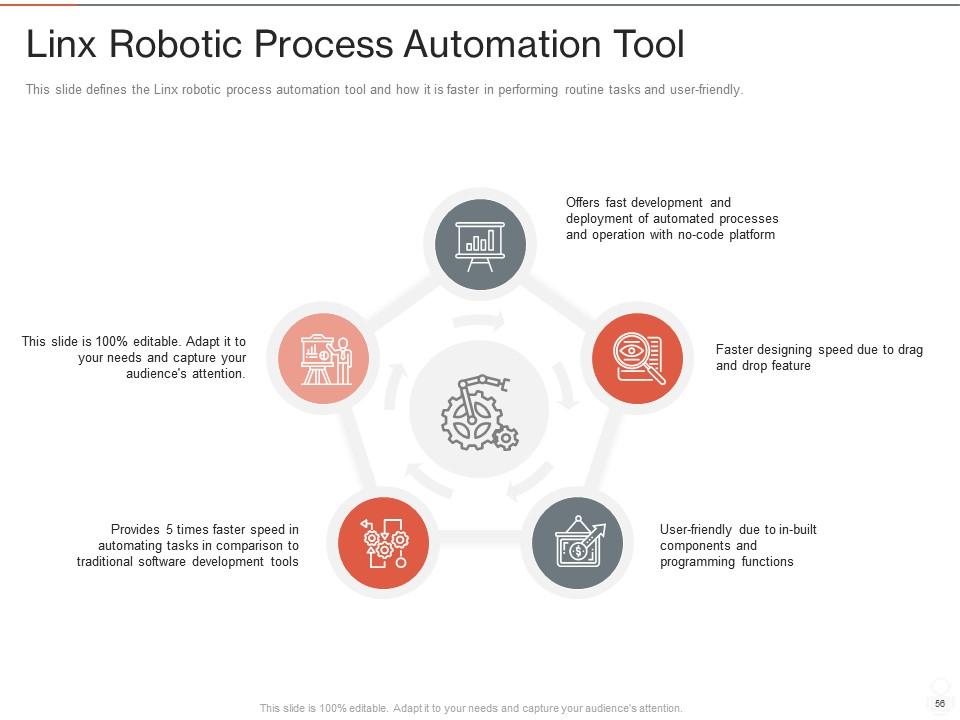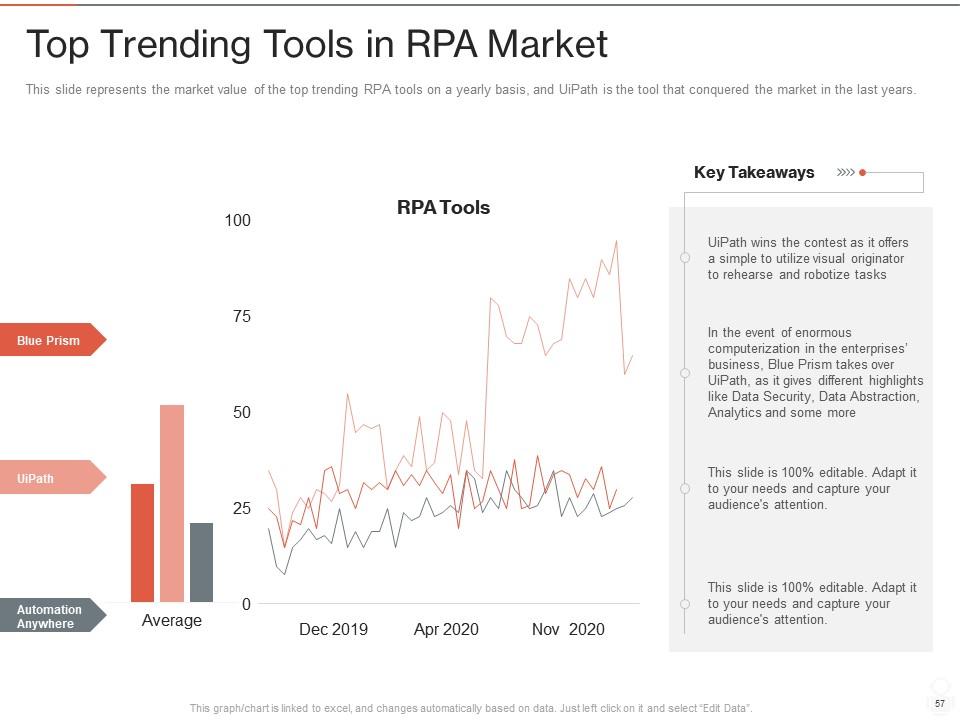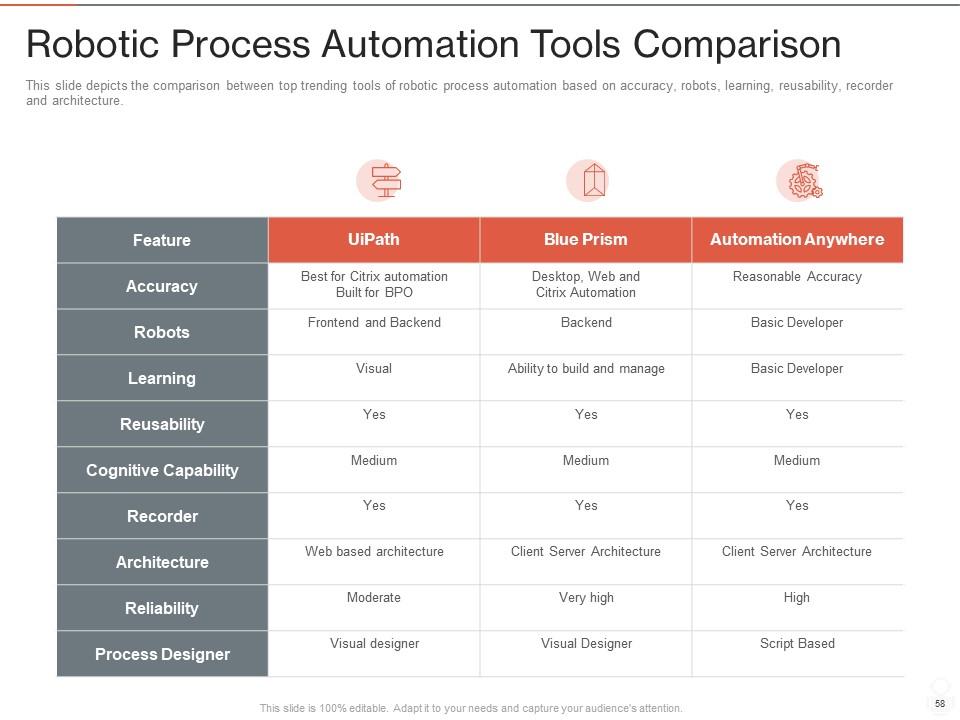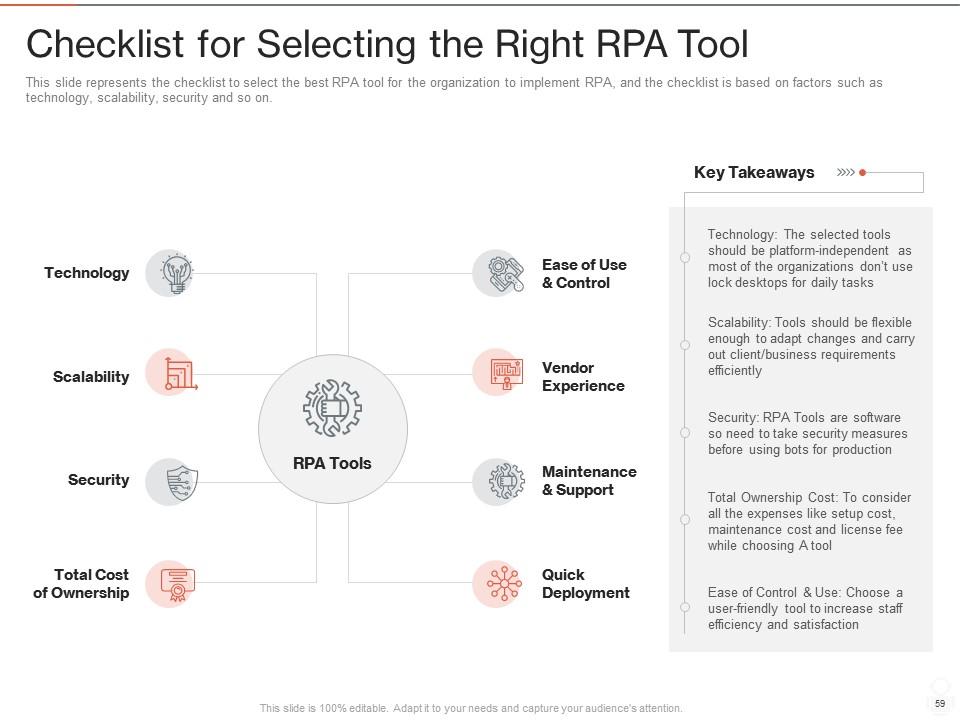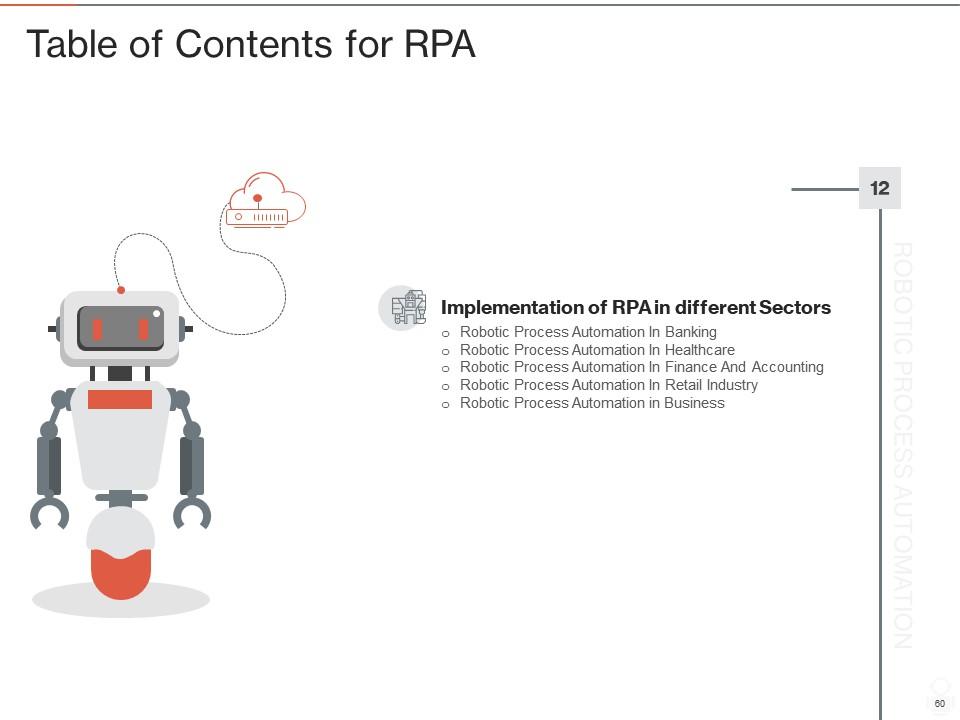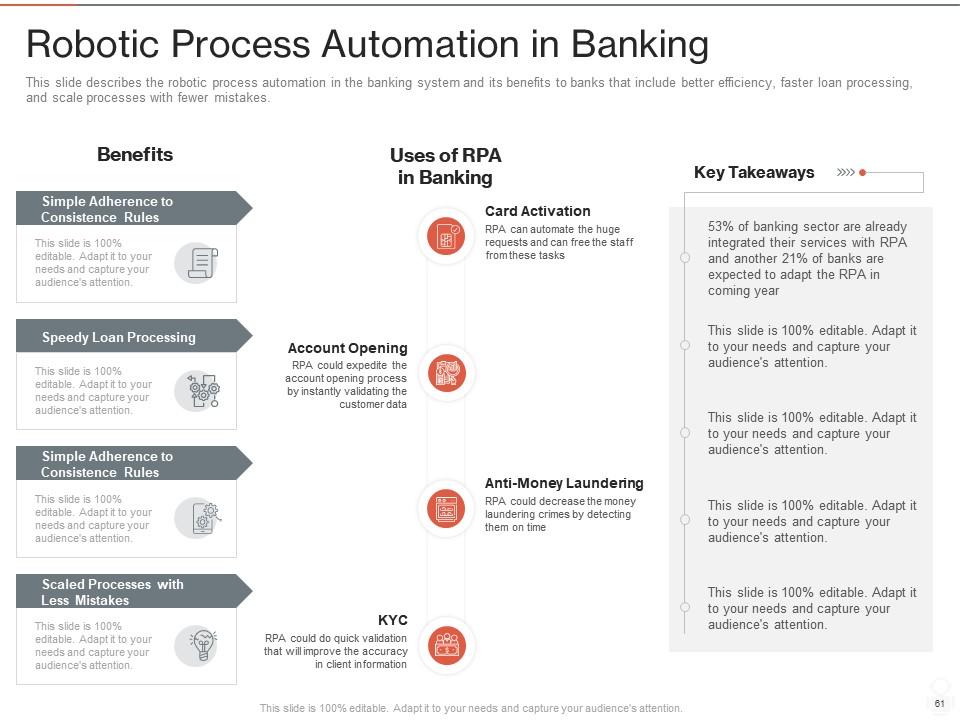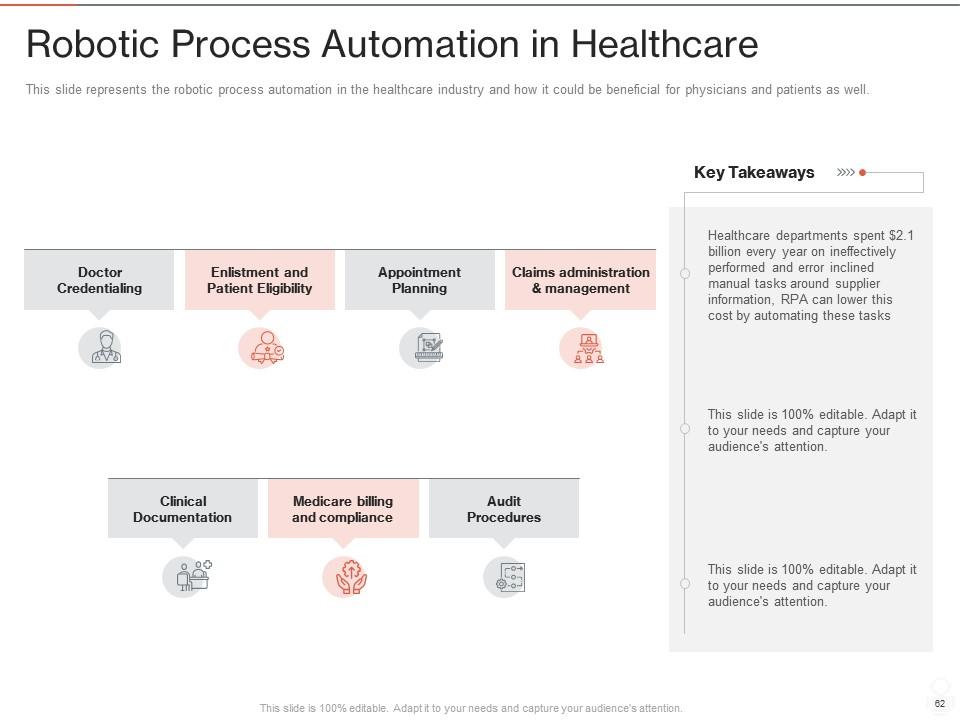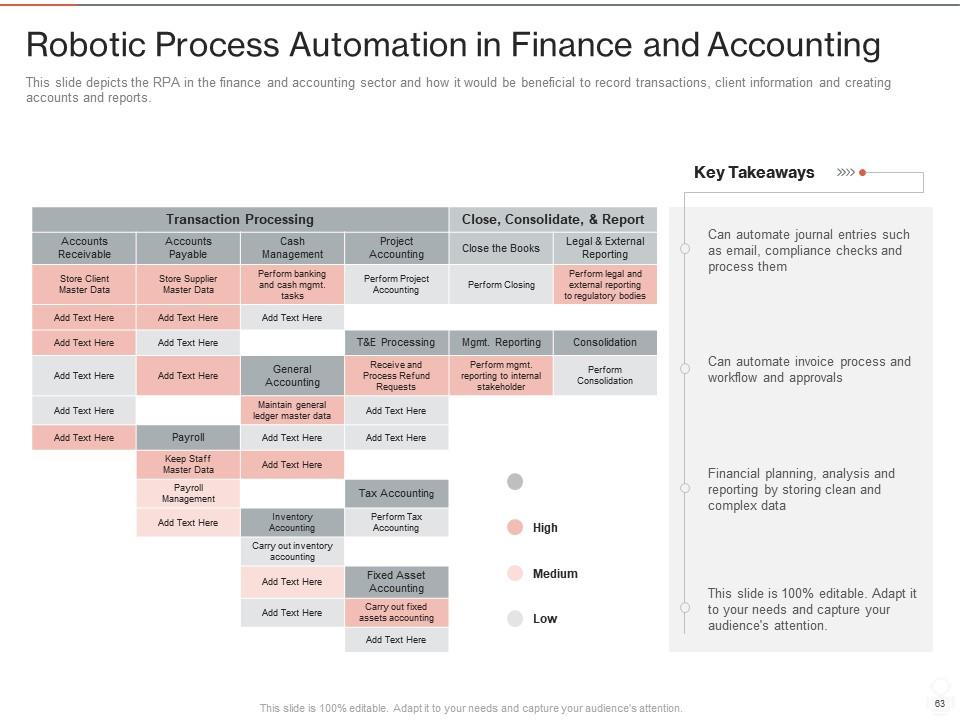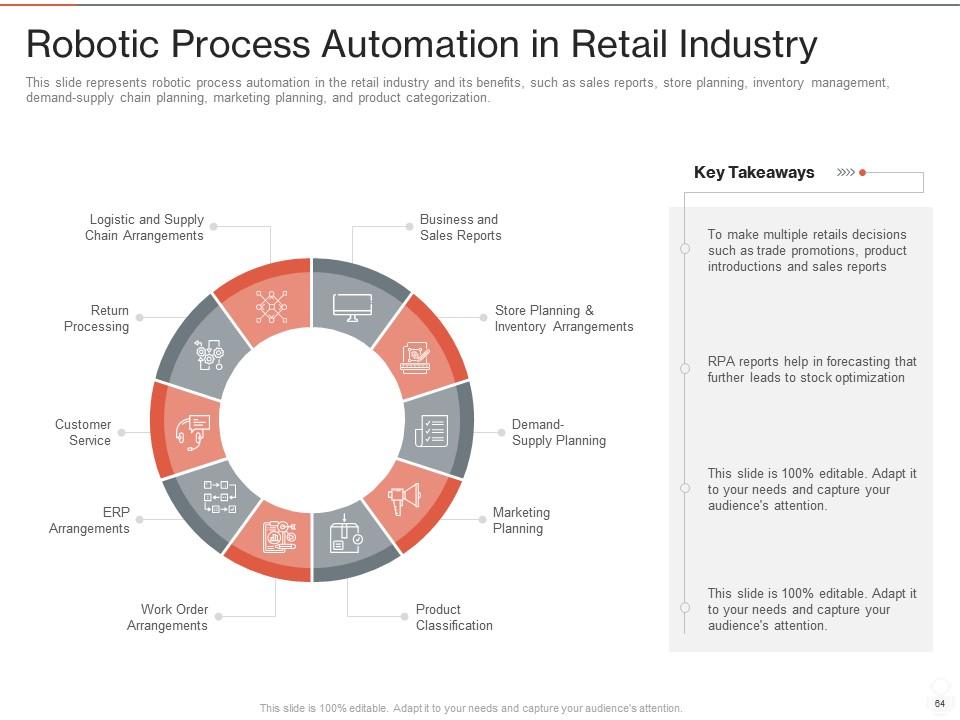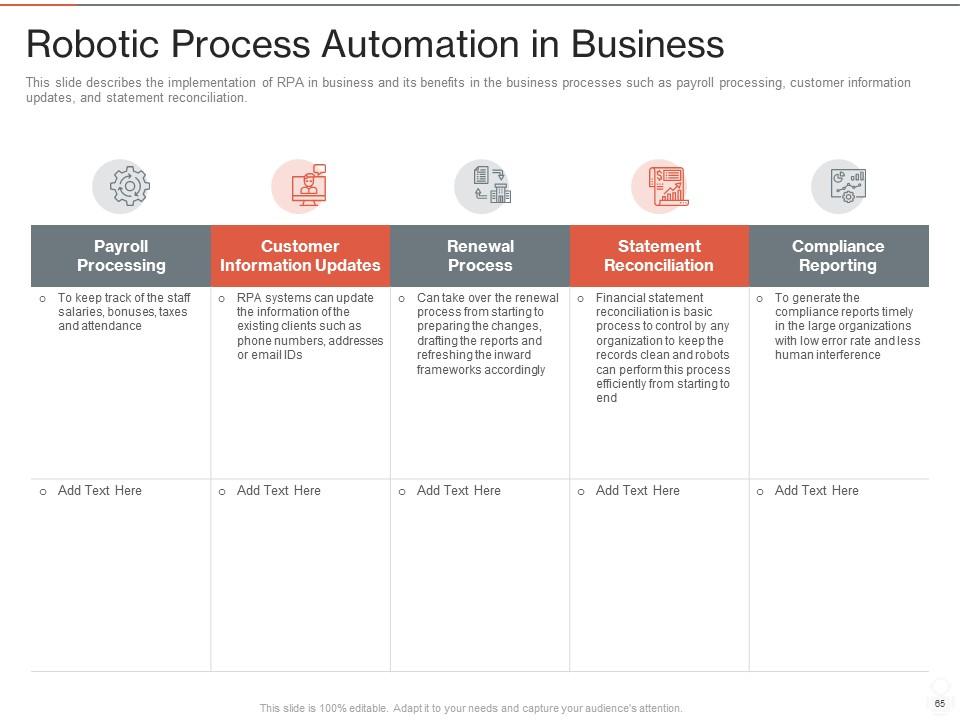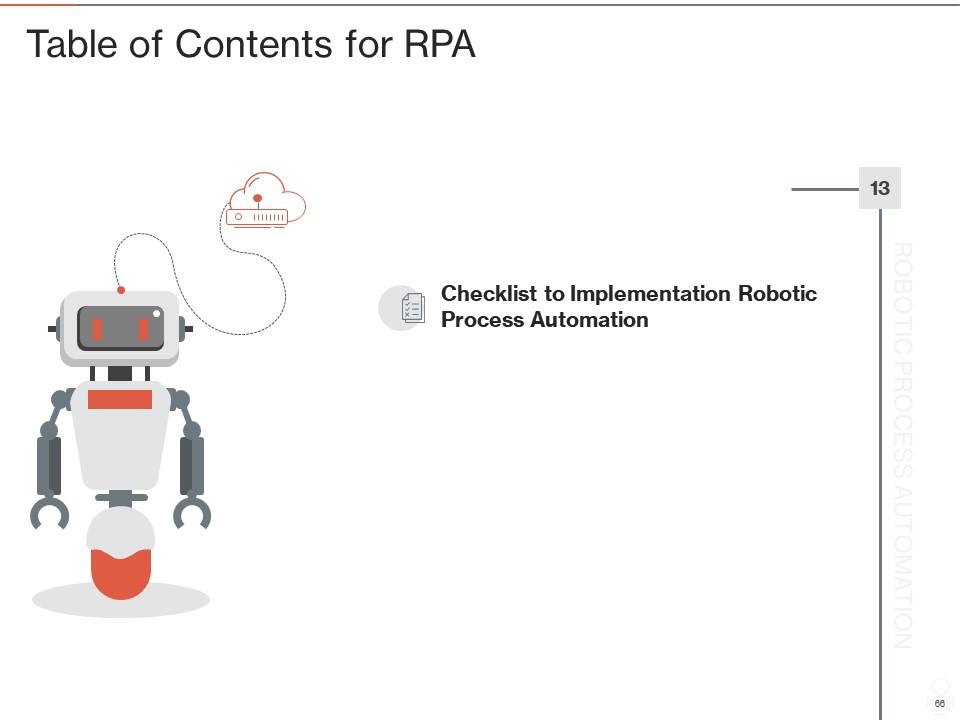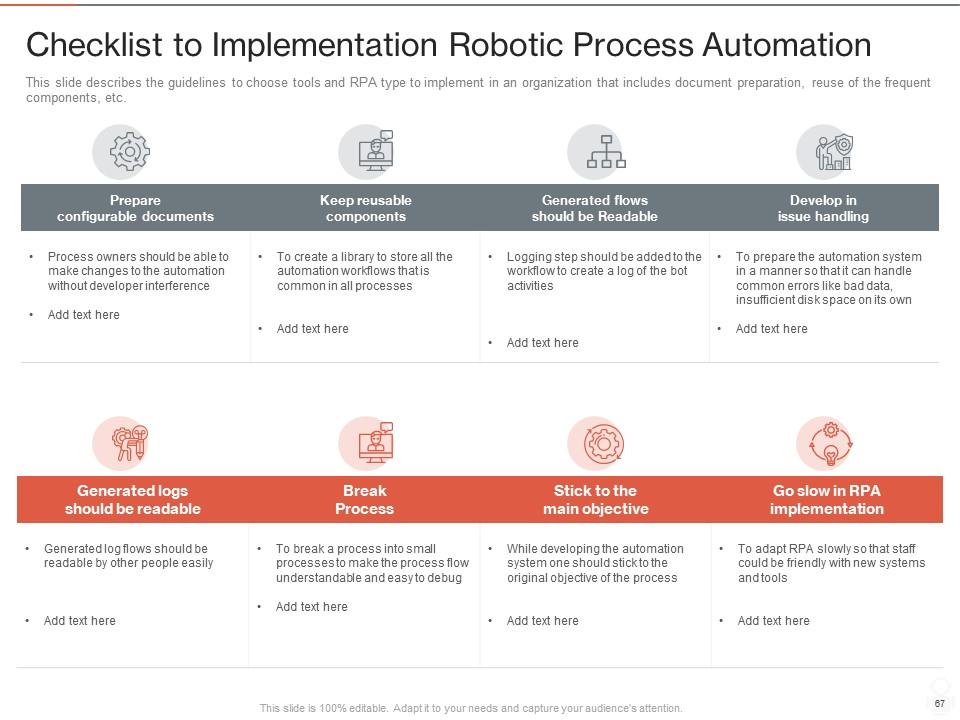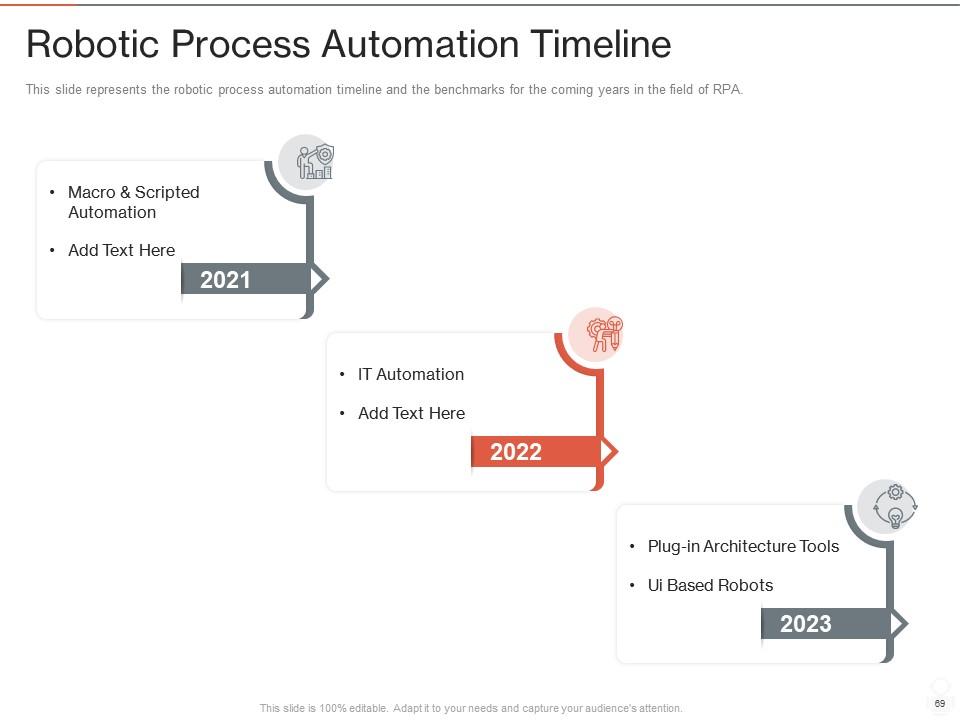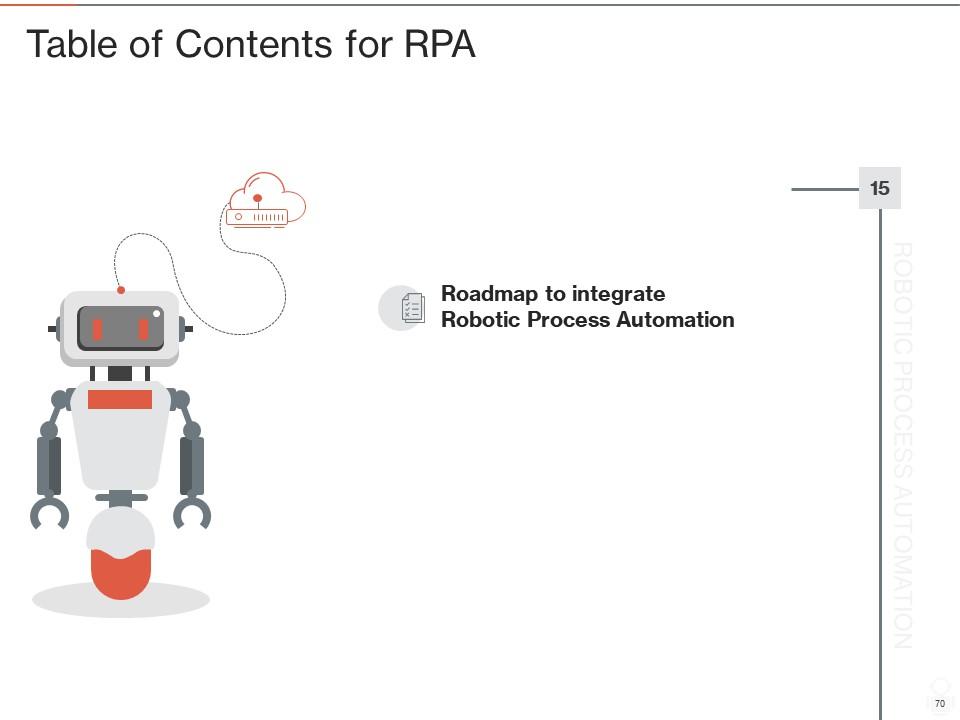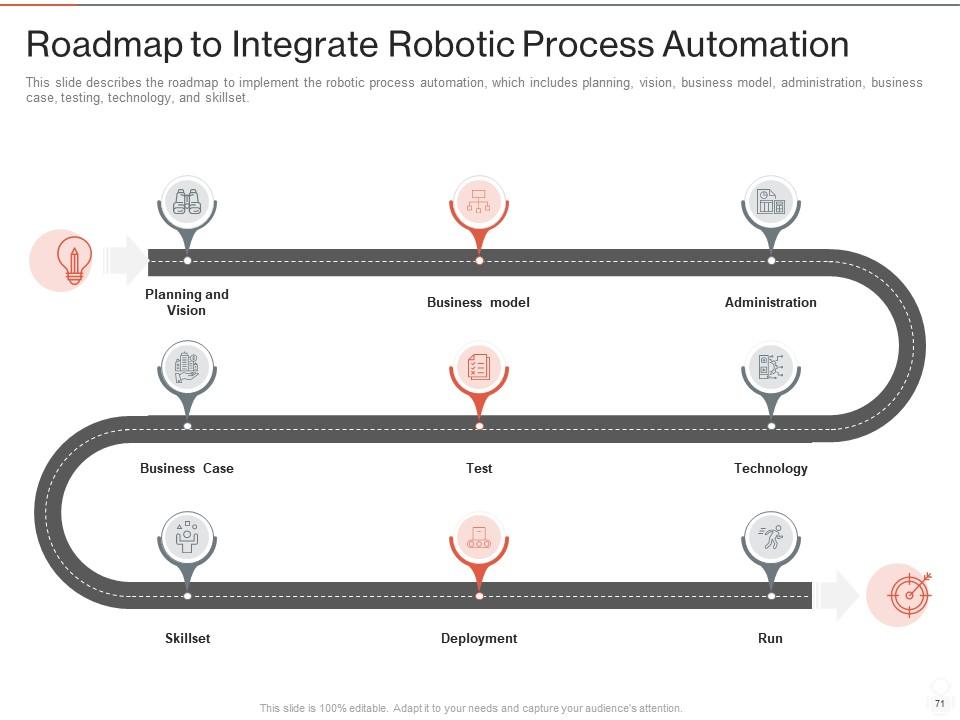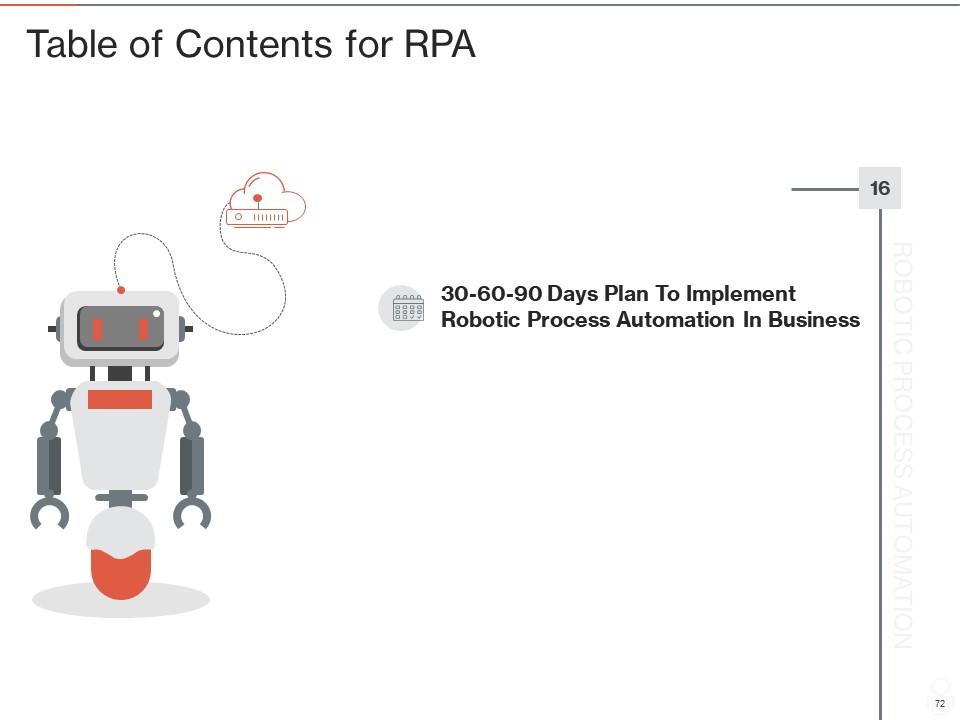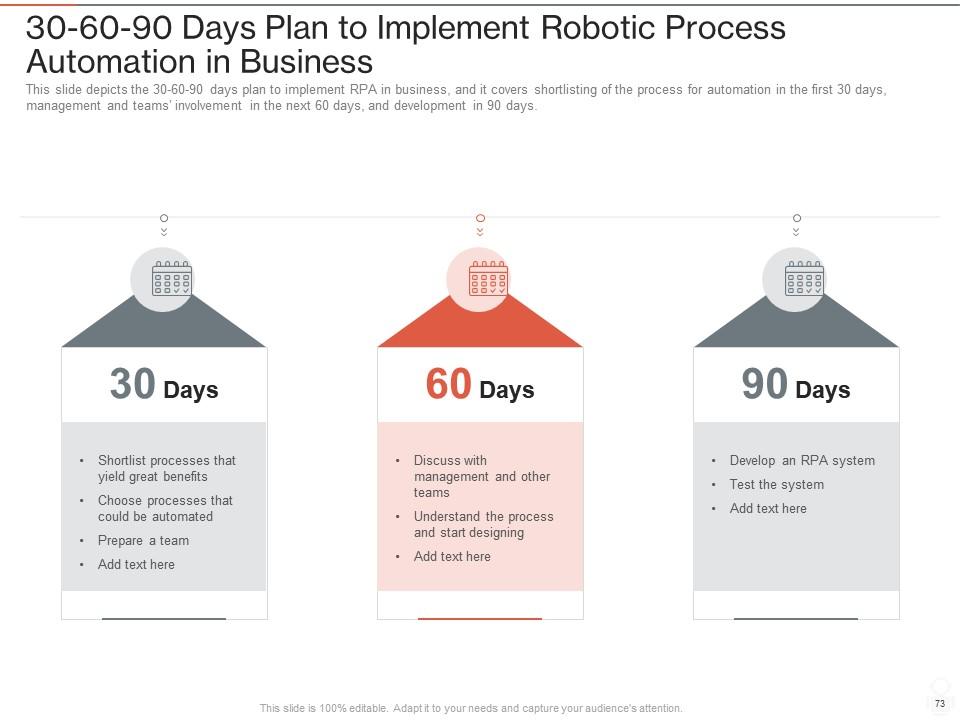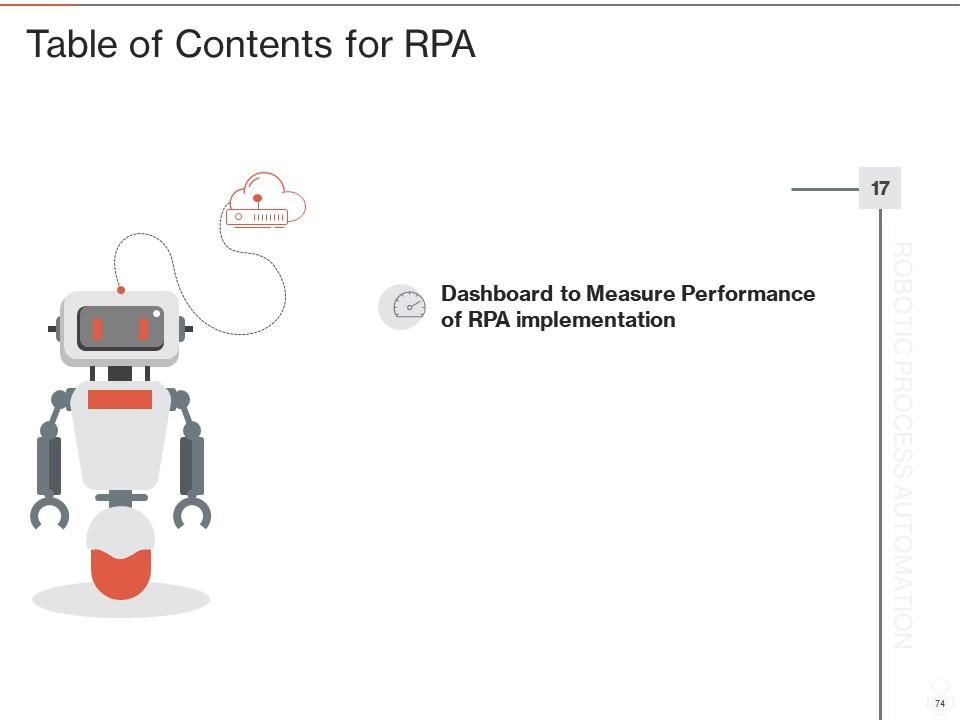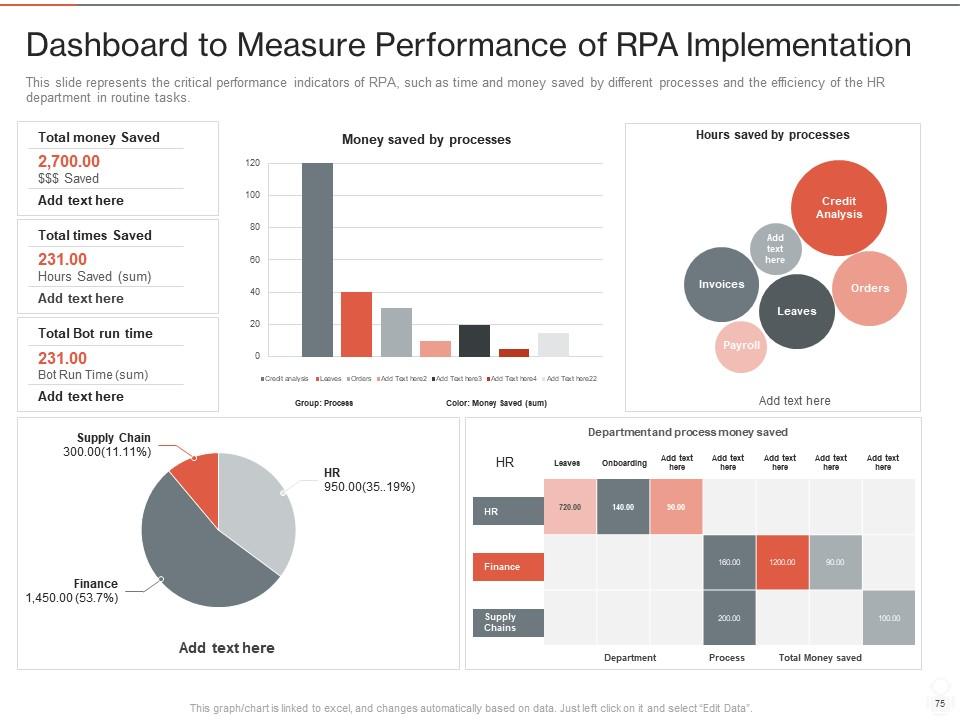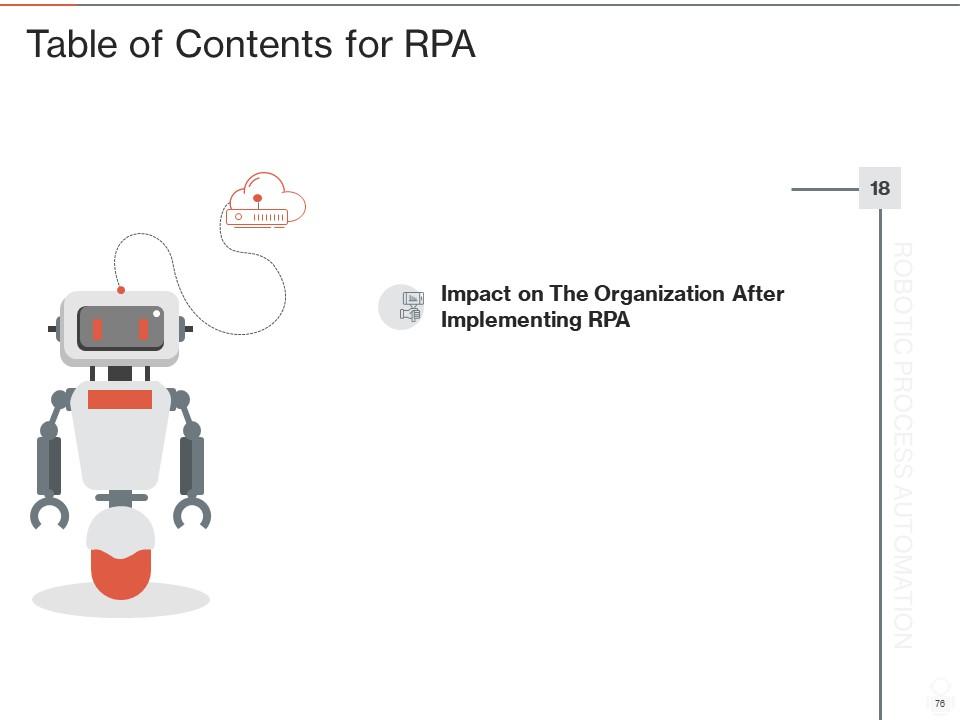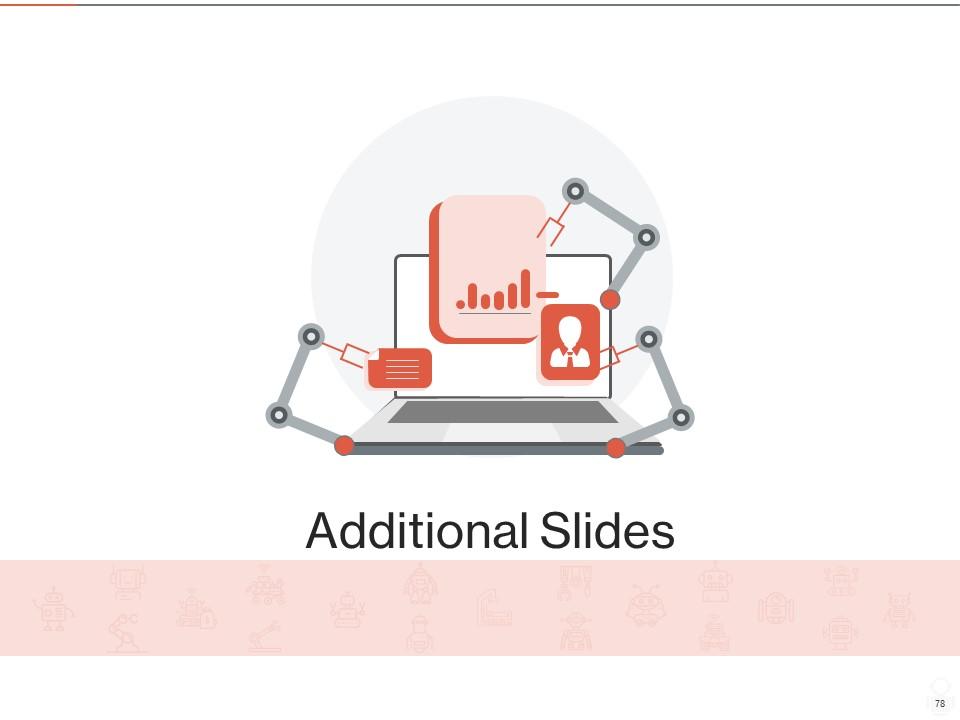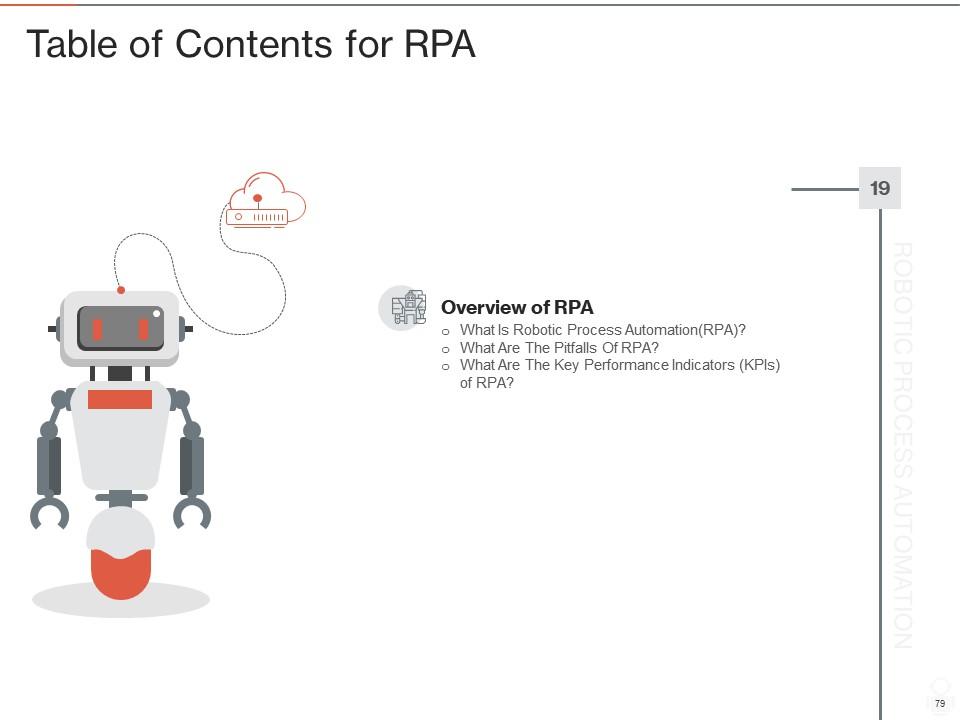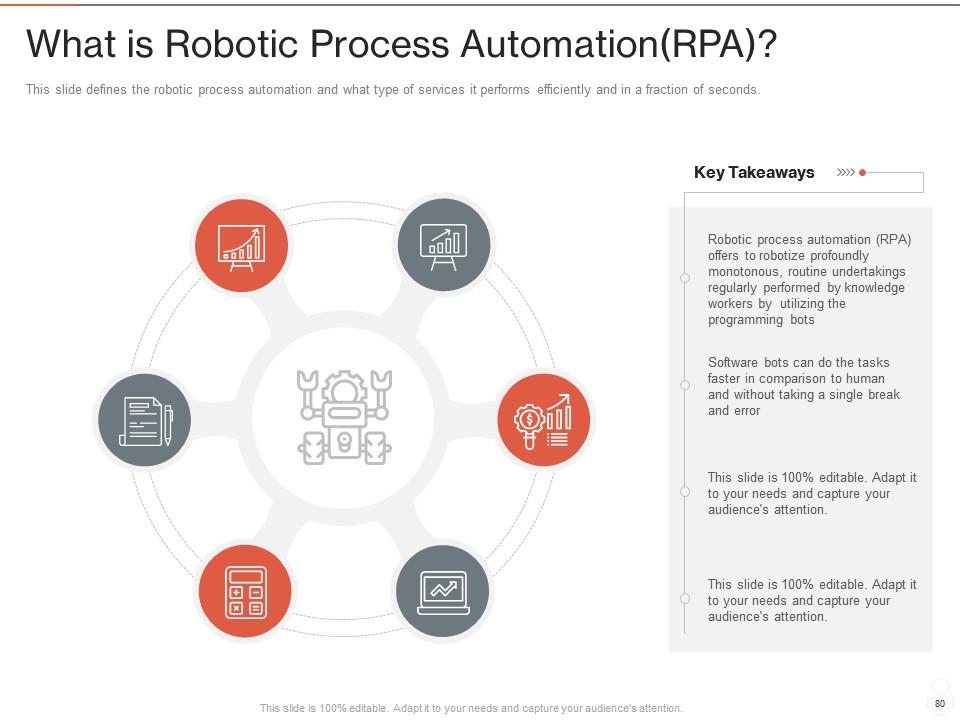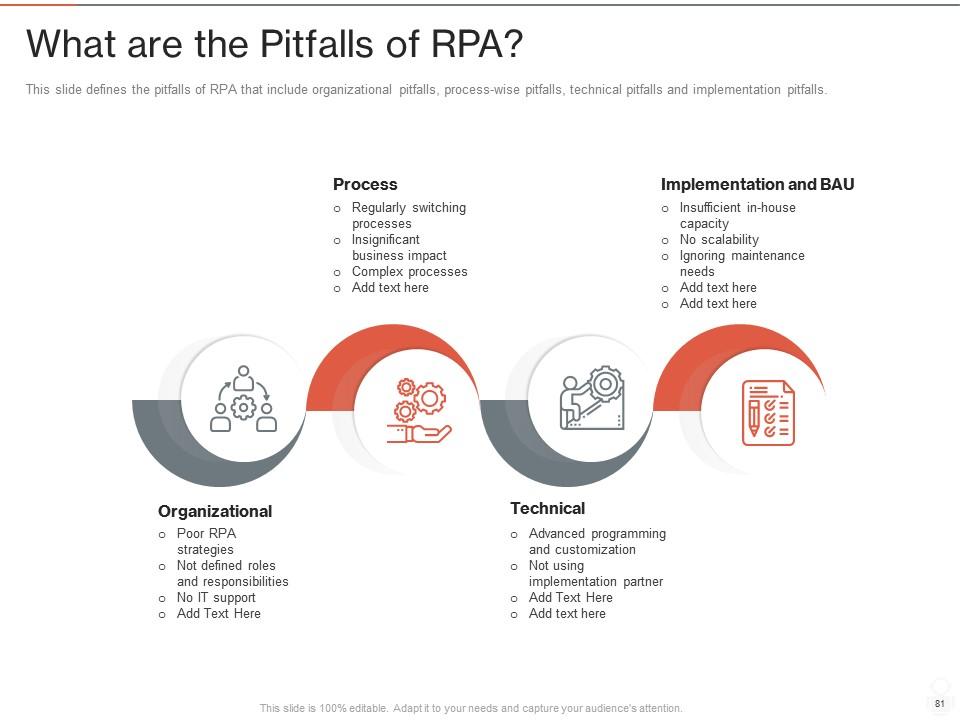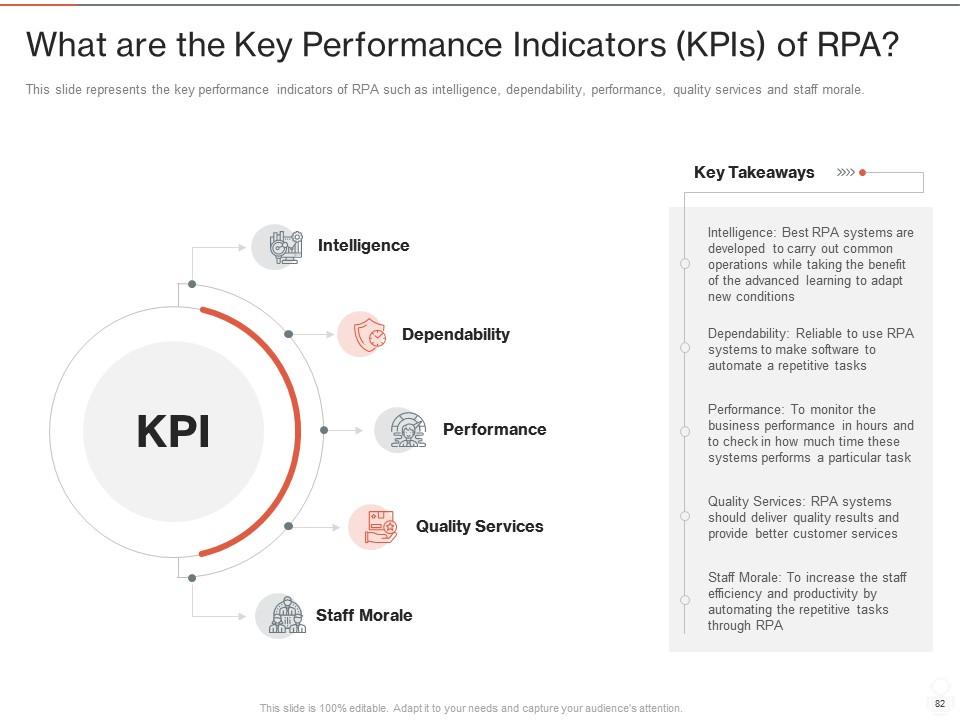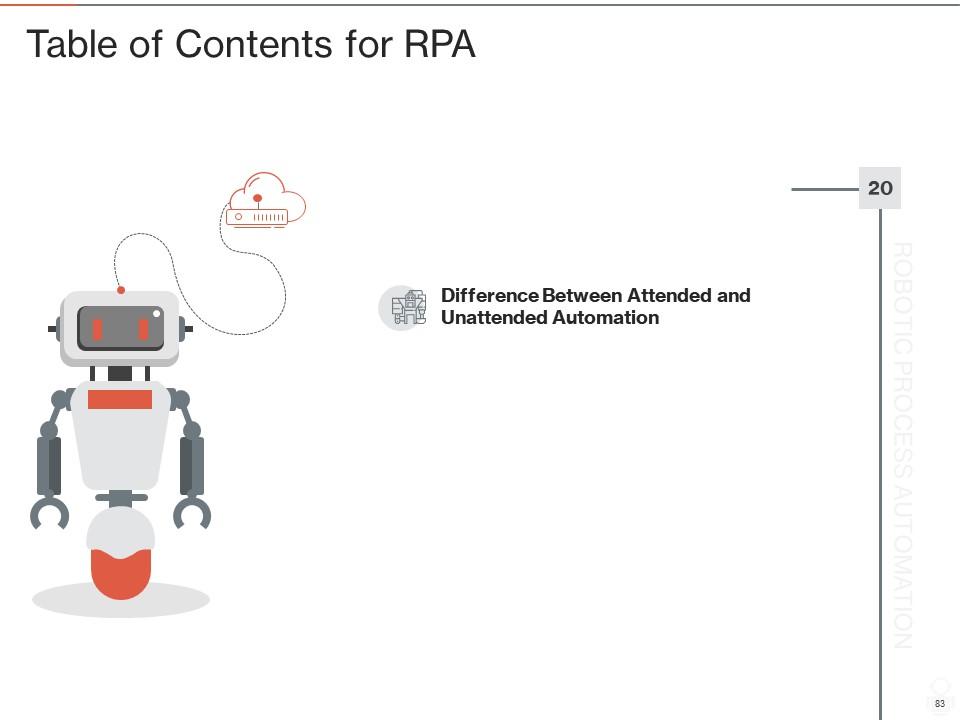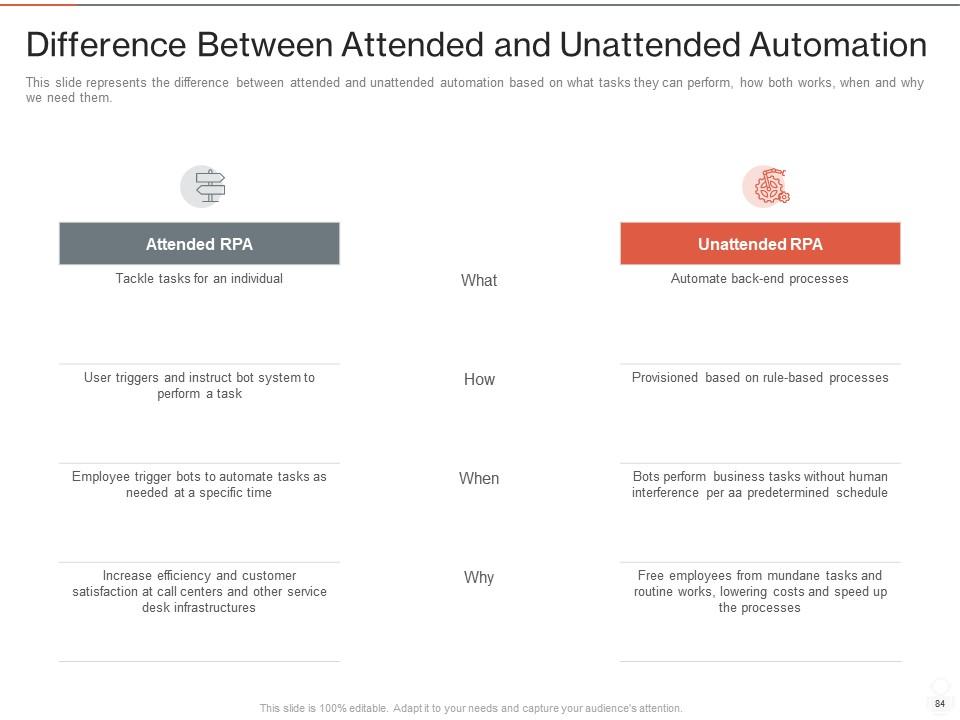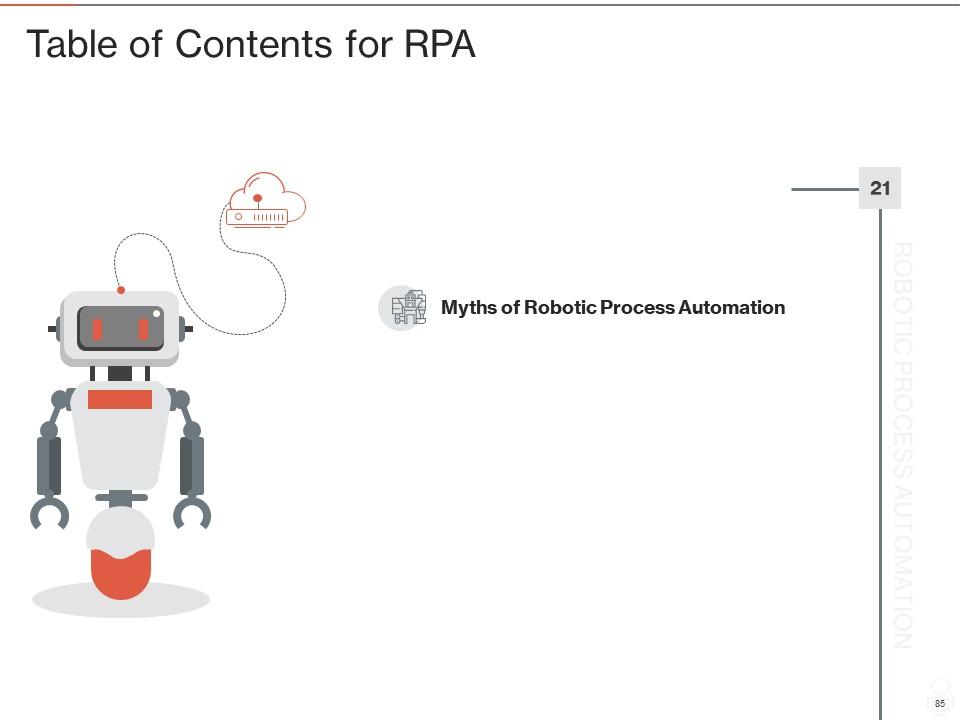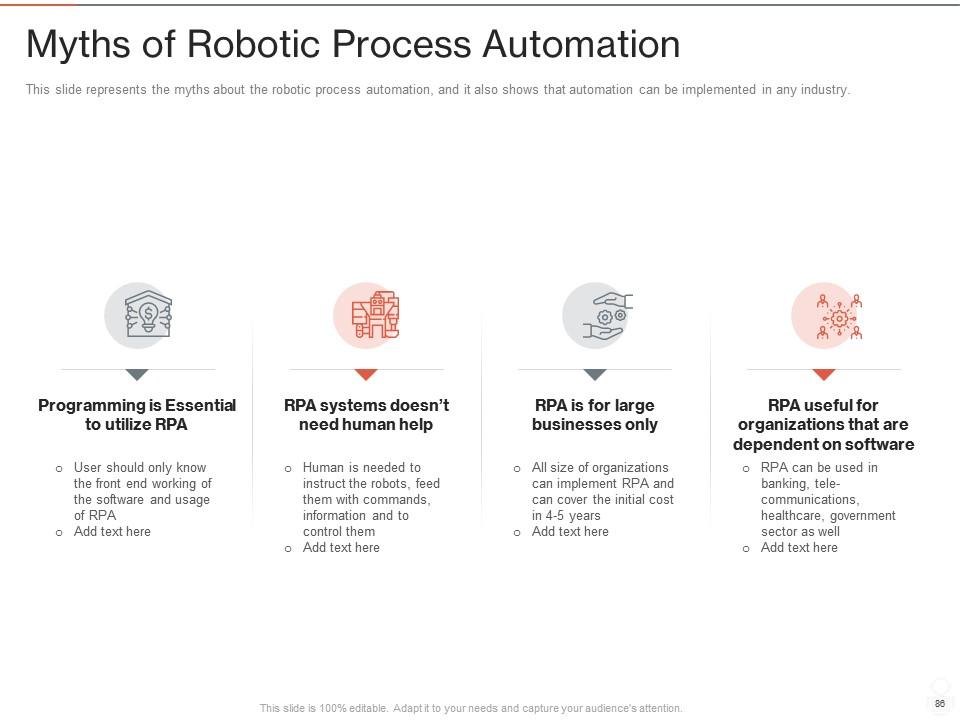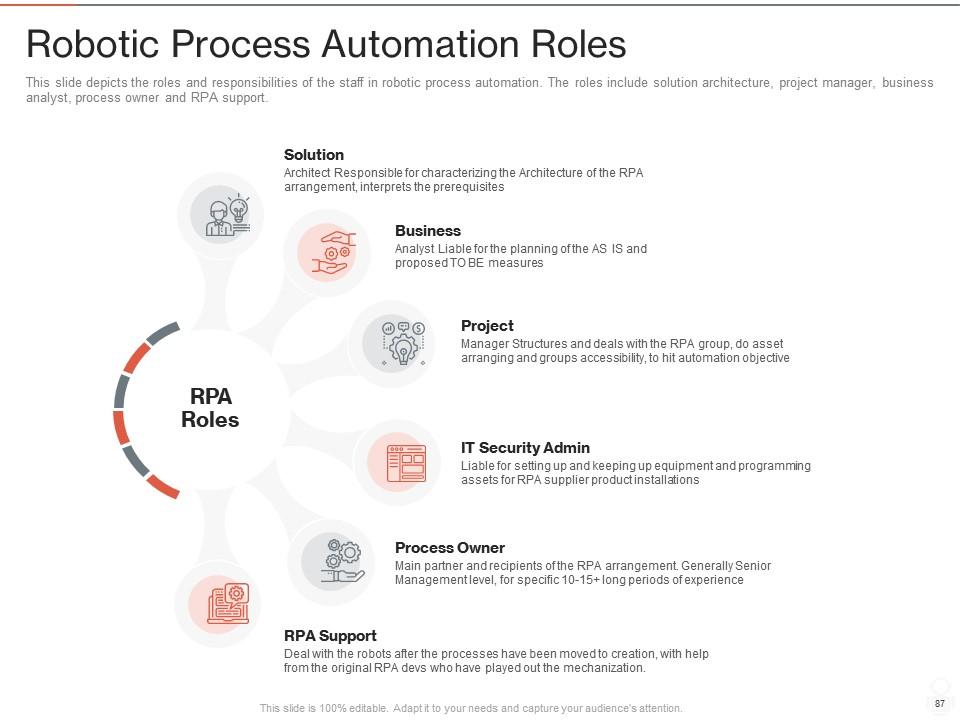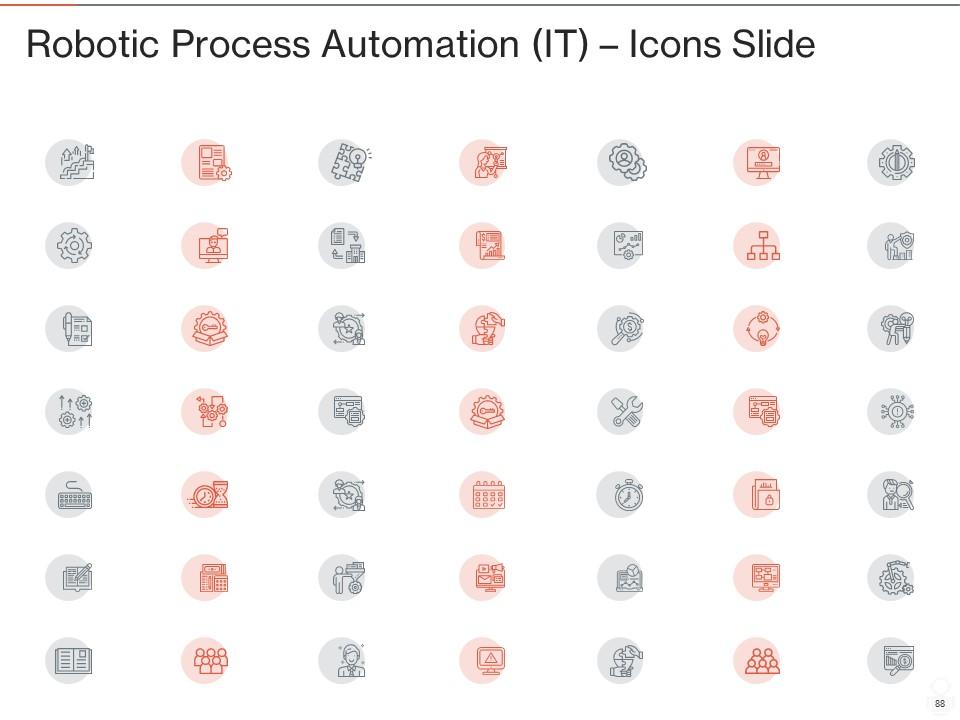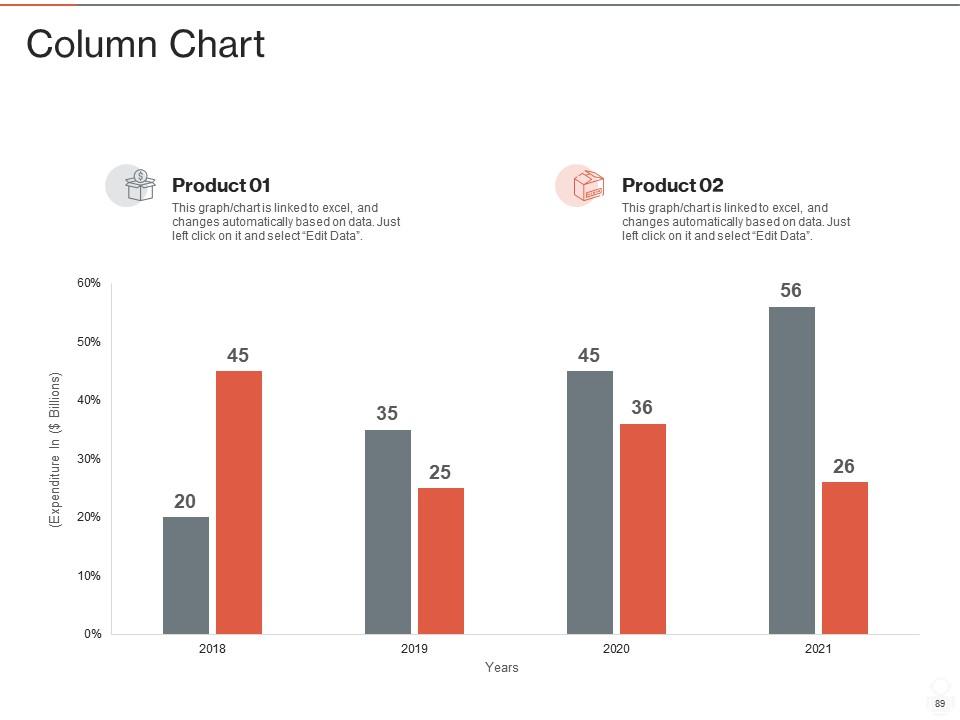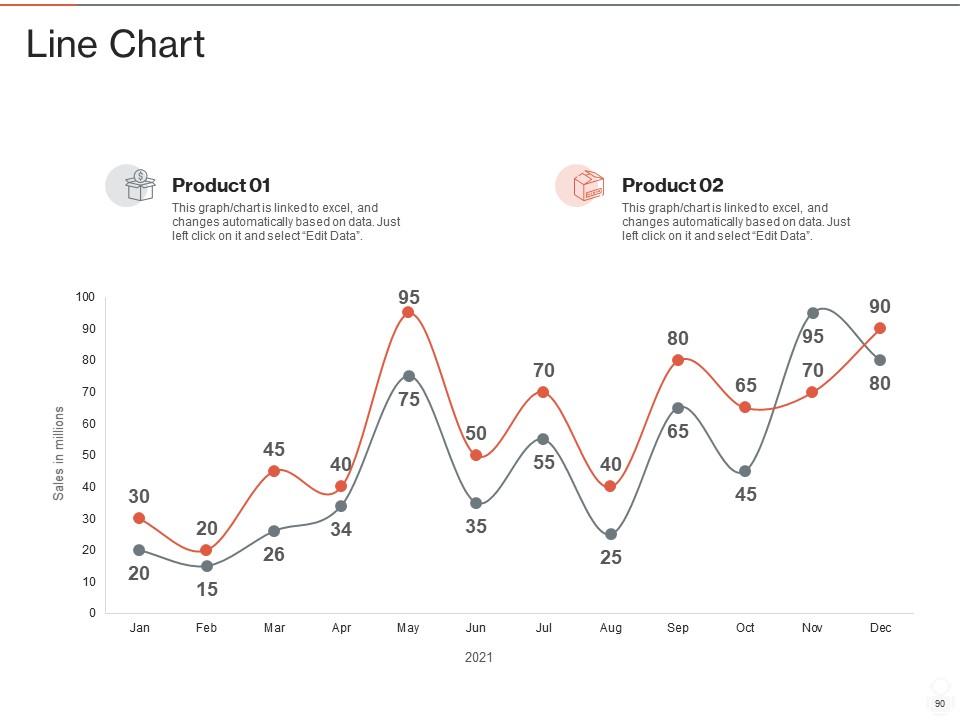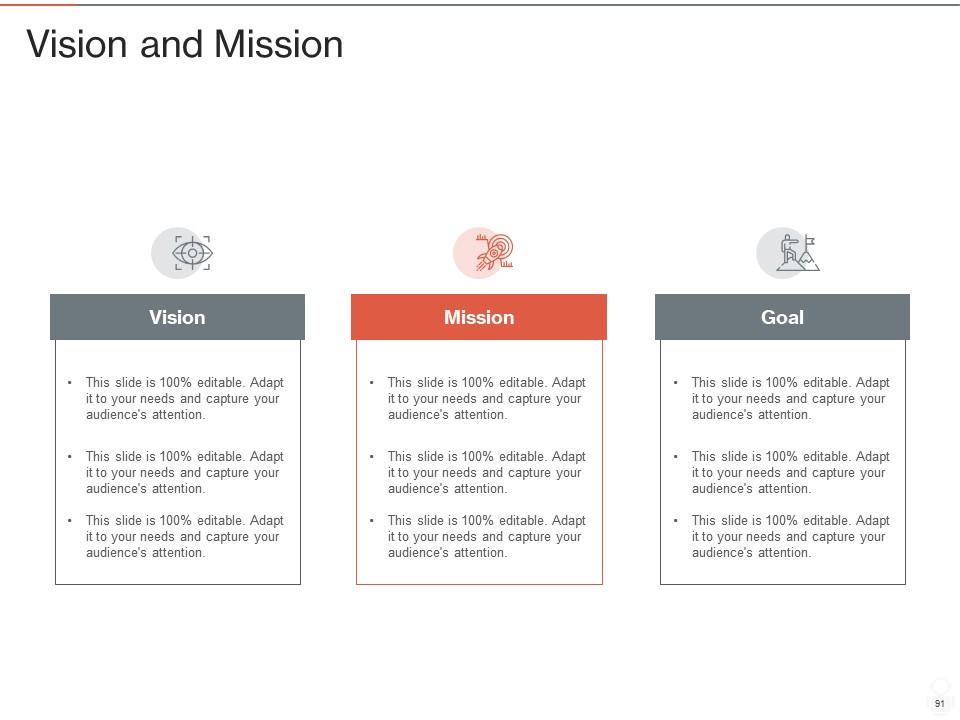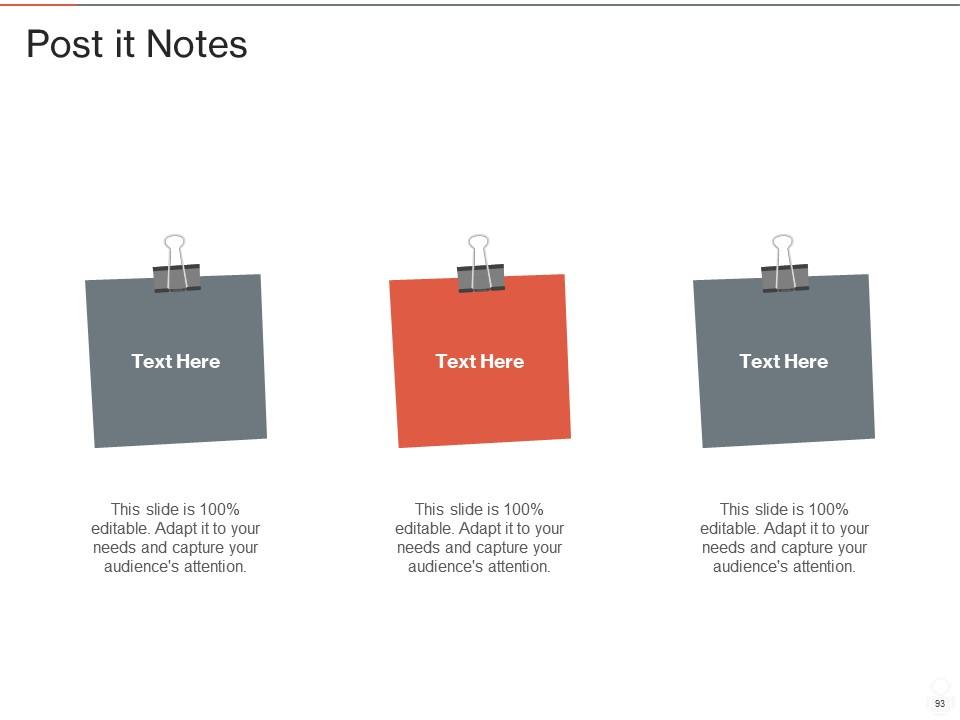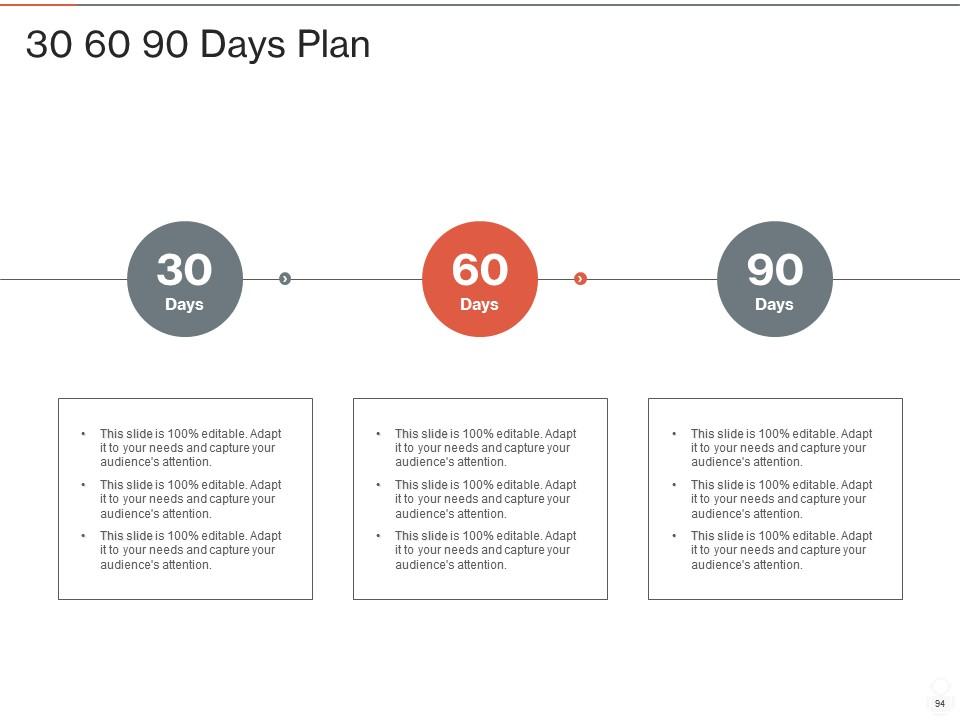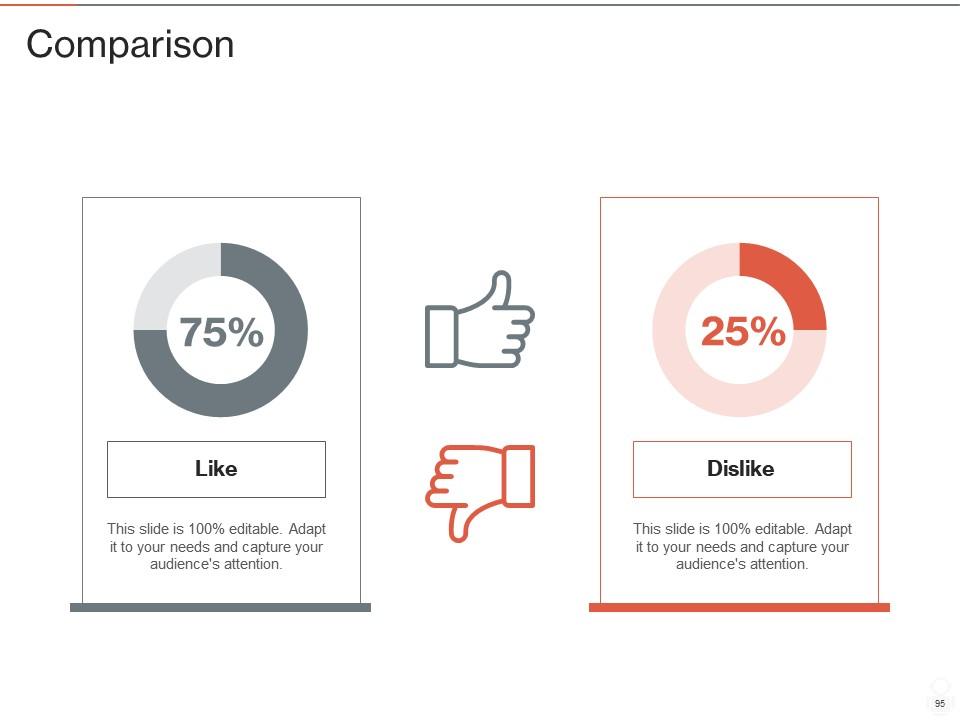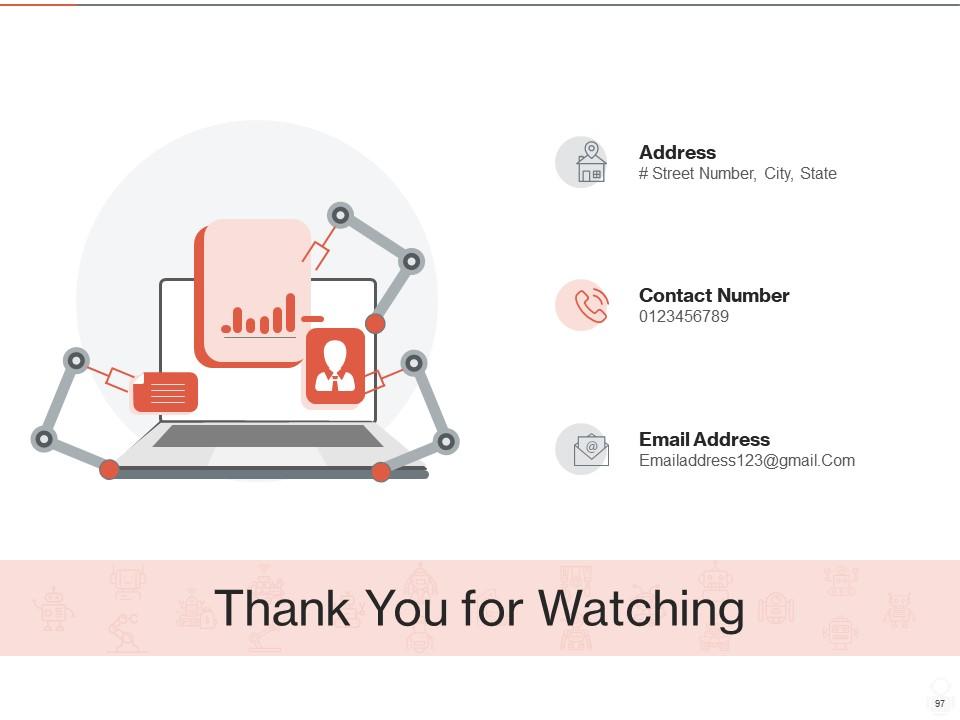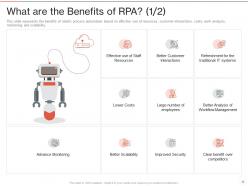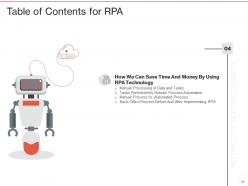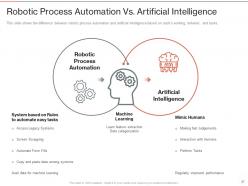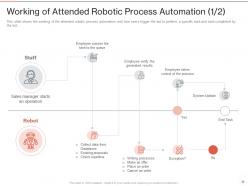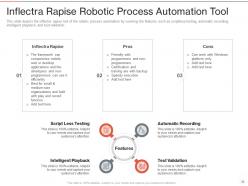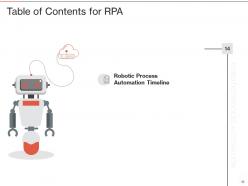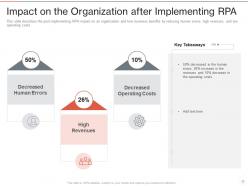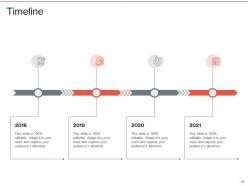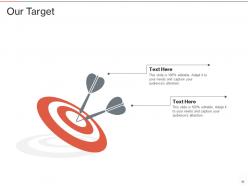Robotic Process Automation IT Powerpoint Presentation Slides
Get access to this editable pitch deck and replace human efforts with bots, to do away with the boredom. Robotic Process Automation RPA is a technology that helps build software robots, manage them and deploy them efficiently. This PowerPoint presentation is of significant assistance to learn about Robotic Process Automation, its benefits, implementation to eliminate business problems such as inefficiency and low employee productivity. This Robotic Process Automation PowerPoint presentation provides a brief overview of RPA, including its features, KPIs, life cycle, and implementation methodologies. Further, this PowerPoint presentation highlights information on the initialization of RPA in the organization and its benefits. In addition, RPA PPT shows the difference between RPA and other technologies such as AI and Selenium. It also depicts information on the working of RPA, its architecture, and different types. Moreover, this automation presentation represents challenges that could arise while implementing RPA in the organization and its solutions and steps to ensure Robotic Process Automation Security. Further, the Artificial Intelligence template illustrated information about the RPA tools, implementation of RPA in different sectors. It also comes with content-ready slides to create a checklist to implement RPA in business, a timeline, and a roadmap to monitor the implementation process. Lastly, the Automatic Technology deck comprises a 30-60-90-day plan to implement RPA in business, a dashboard to measure the performance and impact of the RPA implementation in the organization. Download our 100 percent editable and customizable Robotic process automation powerpoint presentation template , which is also compatible with Google Slides.
Get access to this editable pitch deck and replace human efforts with bots, to do away with the boredom. Robotic Process Au..
- Google Slides is a new FREE Presentation software from Google.
- All our content is 100% compatible with Google Slides.
- Just download our designs, and upload them to Google Slides and they will work automatically.
- Amaze your audience with SlideTeam and Google Slides.
-
Want Changes to This PPT Slide? Check out our Presentation Design Services
- WideScreen Aspect ratio is becoming a very popular format. When you download this product, the downloaded ZIP will contain this product in both standard and widescreen format.
-

- Some older products that we have may only be in standard format, but they can easily be converted to widescreen.
- To do this, please open the SlideTeam product in Powerpoint, and go to
- Design ( On the top bar) -> Page Setup -> and select "On-screen Show (16:9)” in the drop down for "Slides Sized for".
- The slide or theme will change to widescreen, and all graphics will adjust automatically. You can similarly convert our content to any other desired screen aspect ratio.
Compatible With Google Slides

Get This In WideScreen
You must be logged in to download this presentation.
PowerPoint presentation slides
This complete deck covers various topics and highlights important concepts. It has PPT slides which cater to your business needs. This complete deck presentation emphasizes Robotic Process Automation IT Powerpoint Presentation Slides and has templates with professional background images and relevant content. This deck consists of total of ninty six slides. Our designers have created customizable templates, keeping your convenience in mind. You can edit the color, text and font size with ease. Not just this, you can also add or delete the content if needed. Get access to this fully editable complete presentation by clicking the download button below.
People who downloaded this PowerPoint presentation also viewed the following :
Content of this Powerpoint Presentation
Slide 1: This is the cover slide for Robotic Process Automation PowerPoint deck
Slide 2: This slide presents the Agenda for the Robotic Automation Process.
Slide 3: This is the Table of Contents for RPA that lists out the elements covered in the deck.
Slide 4: This is the Table of Contents for RPA that lists out the elements covered in the deck.
Slide 5: This slide presents the present situation of the company in front of the audience.
Slide 6: This slide depicts the monthly analysis of the organization’s current situation by covering details of staff engagement, efficiency and productivity, errors and level of customer service.
Slide 7: This slide represents the need for robotic process automation in organizations and how they can expedite the mundane processes that are time-consuming and exhausting.
Slide 8: This slide defines the gap in the organization and how it can be improved through RPA implementation by properly utilizing the business resources.
Slide 9: This slide represents the need to automate repetitive tasks or operations and how it affects the employees and customers.
Slide 10: This slide provides an introduction to RPA
Slide 11: This slide depicts the features of the robotic process automation, which includes work queues, user-friendly, non-disruptive, scalability, analytics and no need for programming knowledge.
Slide 12: This slide represents the benefits of robotic process automation based on effective use of resources, customer interactions, costs, work analysis, monitoring and scalability.
Slide 13: This slide describes the advantages of RPA based on preciseness, technical barrier, compliance, employee morale, productivity, reliability and consistency.
Slide 14: This slide represents the life cycle of robotic process automation, and it covers analysis, bot development, testing of the developed bot and support and maintenance.
Slide 15: This slide describes the methodology to implement robotic process automation in an organization, and it includes planning, development, testing and support & maintenance.
Slide 16: This slide introduces initialization of RPA in the organization.
Slide 17: This slide depicts the implementation journey of robotic process automation in an organization, including learning, identification, testing, selection, expand and measure.
Slide 18: This slide represents the different stages of the RPA implementation journey, which includes preparing RPA, design, develop RPA, testing, settle RPA, and consistent improvement.
Slide 19: This slide depicts the roles of solution architect, business analyst, project manager, IT security admin, process owner of the robotic process automation and their responsibilities and duties.
Slide 20: This slide talks about how we can save time and money by introducing RPA Technology.
Slide 21: This slide describes the manual processing of data and different tasks in an organization that employees carry out daily.
Slide 22: This slide depicts the daily tasks performed by the robotic automation process and how RPA performs these tasks efficiently, instantly and error-free.
Slide 23: This slide depicts the manual versus automated processes. It also shows the number of resources uses to perform each task along with its costs before and after implementing RPA.
Slide 24: This slide represents the back-office processes of an organization before and after implementing RPA and how bots can perform all the operations with a bit of intervention of staff.
Slide 25: This slide introduces RPA with other technologies.
Slide 26: This slide defines if RPA is the same as artificial intelligence and how goals could be achieved by combining these two technologies.
Slide 27: This slide shows the difference between robotic process automation and artificial intelligence-based on each's working, behavior, and tasks.
Slide 28: This slide represents the difference between robotic process automation and selenium, covering facts such as tasks and coding knowledge.
Slide 29: This slide introduces RPA working
Slide 30: This slide represents the working environment of robotic process automation and how operations are shifted between humans and bots to complete a task.
Slide 31: This slide defines how robotic process automation works in the cloud, desktop automation, enterprise automation, and in-house mainframe.
Slide 32: This slide represents the workflow model of robotic process automation and it includes process developers, robot controllers, bots and business users.
Slide 33: This slide introduces Architecture of RPA
Slide 34: This slide depicts the architecture of robotic process automation and how it can be implemented in an organization.
Slide 35: This slide introduces Types of RPA
Slide 36: This slide represents the different types of robotic process automation, such as attended RPA, unattended RPA, and hybrid RPA.
Slide 37: This slide defines the attended robotic process automation and how tasks are performed in this type of automation through human intervention.
Slide 38: This slide shows the working of the attended robotic process automation and how users trigger the bot to perform a specific task and task completed by the bot.
Slide 39: This slide defines the process of performing tasks by attended automation systems. It also shows how bots collect data from multiple systems and generate reports based on that data.
Slide 40: This slide describes the unattended robotic process automation and how it can perform tasks without human intervention.
Slide 41: This slide shows the hybrid type of robotic process automation and how an organization could implement this type of automation in the organization.
Slide 42: This slide introduces Challenges and solutions to implement RPA
Slide 43: This slide depicts the challenges to implementing robotic process automation in an organization, and it includes no technical clarity, lacking commitment, changing process, complex cognitive tasks, and poor planning.
Slide 44: This Slide Depicts The Solutions That Can Be Helpful To Overcome The Challenges Of RPA Implementation And It Includes Staff Training, Transparency, Clear Expectations and Process Selection.
Slide 45: This slide introduces steps to ensure Robotic process automatic security
Slide 46: This slide defines steps to ensure the security of robotic process automation, and it covers guarantee accountability for bot activities, protection from abuse, frauds, logs and bot development.
Slide 47: This slide introduces RPA Tools
Slide 48: This slide represents robotic process automation tools such as Blue Prism, Inflectra Rapise, UiPath, Automation Anywhere, Pega, Nice systems, Kryon and Linx.
Slide 49: This slide describes the blue prism tool of the RPA along with the pros, cons and features of the tool such as robust, 24*7 workforce, information security and execution insight.
Slide 50: This slide depicts the inflectra rapise tool of the robotic process automation by covering the features such as scriptless testing, automatic recording, intelligent playback, and test validation.
Slide 51: This slide represents the UiPath tool that is used for the RPA. It also describes its pros, cons, and feature, namely productivity, usability, extensibility, debugging, and collaboration.
Slide 52: This slide defines the automation anywhere tool for robotic process automation and its pros and cons. It also covers the features of the tool that are intelligent automation, valuable insight and security.
Slide 53: This slide represents the Pega tool used for RPA and its features such as customization, collaboration, publishing, data control, process management, and application design.
Slide 54: This slide describes the nice system tool used for RPA along with its use cases. It also describes its advantages and disadvantages.
Slide 55: This slide depicts the Kryon tool used for robotic process automation and it also defines its benefits and pitfalls.
Slide 56: This slide defines the Linx robotic process automation tool and how it is faster in performing routine tasks and user-friendly.
Slide 57: This slide represents the market value of the top trending RPA tools on a yearly basis, and UiPath is the tool that conquered the market in the last years.
Slide 58: This slide depicts the comparison between top trending tools of robotic process automation based on accuracy, robots, learning, reusability, recorder and architecture.
Slide 59: This slide represents the checklist to select the best RPA tool for the organization to implement RPA, and the checklist is based on factors such as technology, scalability, security and so on.
Slide 60: This slide introduces implementation of RPA in different sectors.
Slide 61: This slide describes the robotic process automation in the banking system and its benefits to banks that include better efficiency, faster loan processing, and scale processes with fewer mistakes.
Slide 62: This slide represents the robotic process automation in the healthcare industry and how it could be beneficial for physicians and patients as well.
Slide 63: This slide depicts the RPA in the finance and accounting sector and how it would be beneficial to record transactions, client information and creating accounts and reports.
Slide 64: This slide represents robotic process automation in the retail industry and its benefits, such as sales reports, store planning, inventory management, demand-supply chain planning, marketing planning, and product categorization.
Slide 65: This slide describes the implementation of RPA in business and its benefits in the business processes such as payroll processing, customer information updates, and statement reconciliation.
Slide 66: This slide introduces the Checklist to Implement Robotic Process Automation
Slide 67: This slide describes the guidelines to choose tools and RPA type to implement in an organization that includes document preparation, reuse of the frequent components, etc.
Slide 68: This slide introduces robotic process automation timeline
Slide 69: This slide represents the robotic process automation timeline and the benchmarks for the coming years in the field of RPA.
Slide 70: This slide introduces Roadmap to integrate Robotic Process Automation
Slide 71: This slide describes the roadmap to implement the robotic process automation, which includes planning, vision, business model, administration, business case, testing, technology, and skillset.
Slide 72: 30-60-90 Days Plan To Implement Robotic Process Automation In Business
Slide 73: This slide depicts the 30-60-90 days plan to implement RPA in business, and it covers shortlisting of the process for automation in the first 30 days, management and teams’ involvement in the next 60 days, and development in 90 days.
Slide 74: This slide introduces Dashboard to Measure Performance of RPA implementation
Slide 75: This slide represents the critical performance indicators of RPA, such as time and money saved by different processes and the efficiency of the HR department in routine tasks.
Slide 76: This slide introduces impact on the organization after implementing RPA
Slide 77: This slide describes the post-implementing RPA impact on an organization and how business benefits by reducing human errors, high revenues, and low operating costs.
Slide 78: This is an Additional Slide
Slide 79: This slide provides overview of RPA
Slide 80: This slide defines the robotic process automation and what type of services it performs efficiently and in a fraction of seconds.
Slide 81: This slide defines the pitfalls of RPA that include organizational pitfalls, process-wise pitfalls, technical pitfalls and implementation pitfalls.
Slide 82: This slide represents the key performance indicators of RPA such as intelligence, dependability, performance, quality services and staff morale.
Slide 83: This slide presents the difference between attended and unattended automation.
Slide 84: This slide represents the difference between attended and unattended automation based on what tasks they can perform, how both works, when and why we need them.
Slide 85: This slide presents Myths of Robotic Process Automation.
Slide 86: This slide represents the myths about the robotic process automation, and it also shows that automation can be implemented in any industry.
Slide 87: This slide depicts the roles and responsibilities of the staff in robotic process automation. The roles include solution architecture, project manager, business analyst, process owner and RPA support.
Slide 88: This is an Icon slide. Use it as per your needs.
Slide 89: This is a Column Chart slide that can be used to compare two products.
Slide 90: This is a Line Chart slide that helps you compare two different products.
Slide 91: This is Our Mission Our Vision slide to state your mission, vision etc.
Slide 92: This is a Timeline slide that can be used to showcase chronological sequence of events.
Slide 93: This is a Post it Notes slide that can be used to keep the important data at one place.
Slide 94: This is a 30 60 90 Days Plan slide that can be used to formulate robust plans.
Slide 95: This is a Comparison slide that can be used to conduct a comparative analysis between two elements.
Slide 96: This is our Target image slide to showcase your company's target.
Slide 97: This is Thank You slide for acknowledgment. You can share your contact details here.
Robotic Process Automation IT Powerpoint Presentation Slides with all 97 slides:
Use our Robotic Process Automation IT Powerpoint Presentation Slides to effectively help you save your valuable time. They are readymade to fit into any presentation structure.
FAQs
Robotic Process Automation (RPA) is a technology that uses software robots or digital workers to automate repetitive, mundane, and rule-based tasks in a business process. It mimics human actions such as mouse clicks, keystrokes, and data entry, and operates within existing software systems without requiring changes to the underlying infrastructure.
Traditional automation relies on programming, whereas Robotic Process Automation (RPA) uses artificial intelligence (AI) and machine learning (ML) to automate tasks. RPA can adapt to changes in the process, learn from experience, and handle exceptions without requiring significant human intervention.
Robotic Process Automation (RPA) offers several benefits, including increased efficiency, accuracy, and scalability. It can also reduce costs by automating tasks that were previously performed by human workers. RPA can improve the quality of work by eliminating errors and reducing processing times.
Robotic Process Automation (RPA) can automate a wide range of tasks, including data entry, invoice processing, customer service, and supply chain management. It can also be used for more complex processes such as financial reporting, regulatory compliance, and human resources management.
Robotic Process Automation (RPA) is designed with security and compliance in mind. It uses encryption to secure data in transit and at rest, and access to data is limited to authorized personnel. RPA is also compliant with data privacy regulations such as GDPR (General Data Protection Regulation) and (Health Insurance Portability and Accountability Act), as it can be configured to handle sensitive data in a secure and compliant manner.
-
Informative design.
-
Attractive design and informative presentation.


